Master of Engineering Management Thesis: 3D Printing in Construction
VerifiedAdded on 2021/05/31

Thesis In
3D PRINTING IN CONSTRUCTION AND MANAGEMENT
Student Name: Alhareth Hamid
Student ID: 5628167
Supervised by: Dr. Mohammed Watfa
University of Wollongong in Dubai
Page | 1
Paraphrase This Document
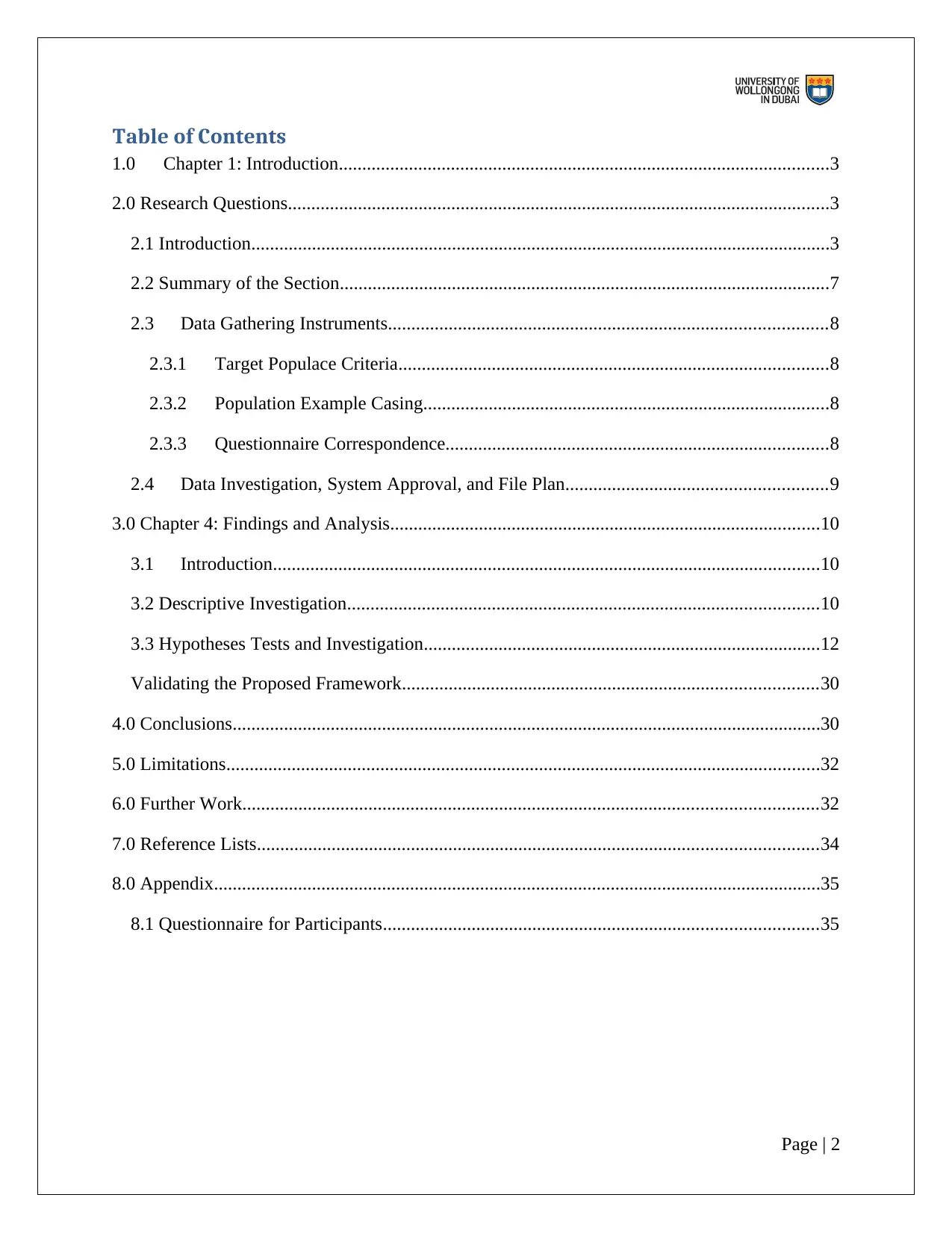
1.0 Chapter 1: Introduction.........................................................................................................3
2.0 Research Questions....................................................................................................................3
2.1 Introduction............................................................................................................................3
2.2 Summary of the Section.........................................................................................................7
2.3 Data Gathering Instruments..............................................................................................8
2.3.1 Target Populace Criteria............................................................................................8
2.3.2 Population Example Casing.......................................................................................8
2.3.3 Questionnaire Correspondence..................................................................................8
2.4 Data Investigation, System Approval, and File Plan........................................................9
3.0 Chapter 4: Findings and Analysis............................................................................................10
3.1 Introduction.....................................................................................................................10
3.2 Descriptive Investigation.....................................................................................................10
3.3 Hypotheses Tests and Investigation.....................................................................................12
Validating the Proposed Framework.........................................................................................30
4.0 Conclusions..............................................................................................................................30
5.0 Limitations...............................................................................................................................32
6.0 Further Work...........................................................................................................................32
7.0 Reference Lists........................................................................................................................34
8.0 Appendix..................................................................................................................................35
8.1 Questionnaire for Participants.............................................................................................35
Page | 2
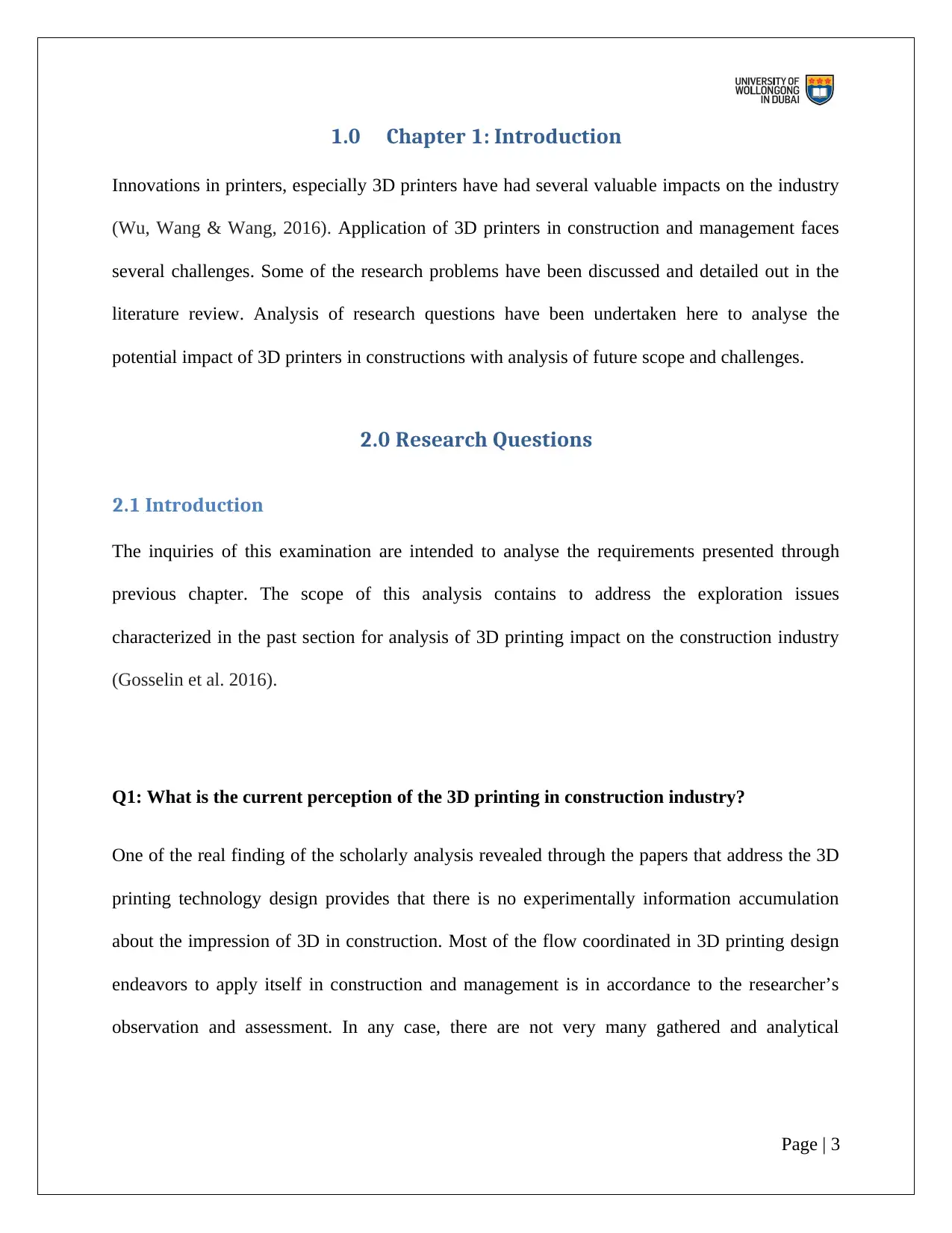
Innovations in printers, especially 3D printers have had several valuable impacts on the industry
(Wu, Wang & Wang, 2016). Application of 3D printers in construction and management faces
several challenges. Some of the research problems have been discussed and detailed out in the
literature review. Analysis of research questions have been undertaken here to analyse the
potential impact of 3D printers in constructions with analysis of future scope and challenges.
2.0 Research Questions
2.1 Introduction
The inquiries of this examination are intended to analyse the requirements presented through
previous chapter. The scope of this analysis contains to address the exploration issues
characterized in the past section for analysis of 3D printing impact on the construction industry
(Gosselin et al. 2016).
Q1: What is the current perception of the 3D printing in construction industry?
One of the real finding of the scholarly analysis revealed through the papers that address the 3D
printing technology design provides that there is no experimentally information accumulation
about the impression of 3D in construction. Most of the flow coordinated in 3D printing design
endeavors to apply itself in construction and management is in accordance to the researcher’s
observation and assessment. In any case, there are not very many gathered and analytical
Page | 3
⊘ This is a preview!⊘
Do you want full access?
Subscribe today to unlock all pages.

Trusted by 1+ million students worldwide
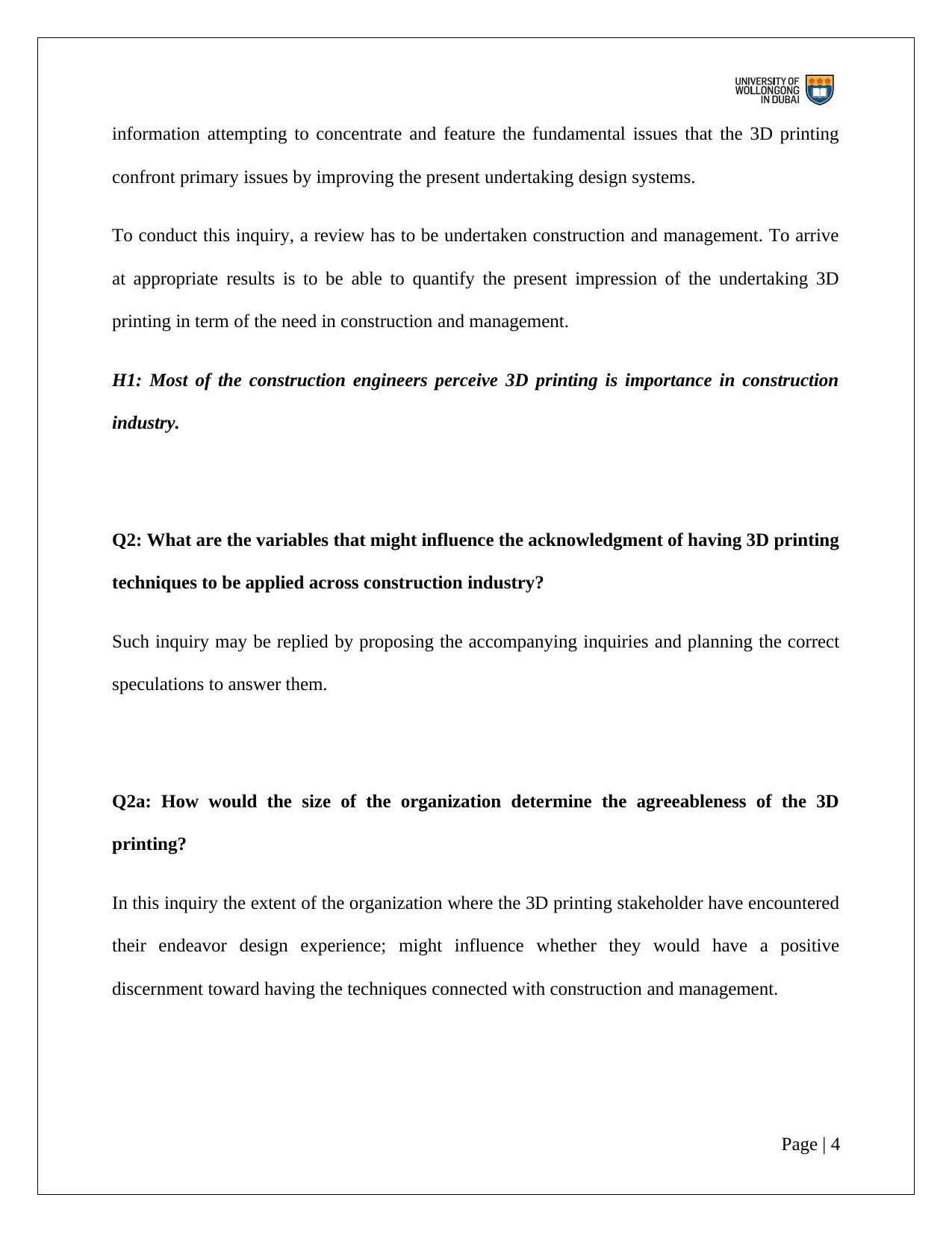
confront primary issues by improving the present undertaking design systems.
To conduct this inquiry, a review has to be undertaken construction and management. To arrive
at appropriate results is to be able to quantify the present impression of the undertaking 3D
printing in term of the need in construction and management.
H1: Most of the construction engineers perceive 3D printing is importance in construction
industry.
Q2: What are the variables that might influence the acknowledgment of having 3D printing
techniques to be applied across construction industry?
Such inquiry may be replied by proposing the accompanying inquiries and planning the correct
speculations to answer them.
Q2a: How would the size of the organization determine the agreeableness of the 3D
printing?
In this inquiry the extent of the organization where the 3D printing stakeholder have encountered
their endeavor design experience; might influence whether they would have a positive
discernment toward having the techniques connected with construction and management.
Page | 4
Paraphrase This Document

on the construction.
Q2b: Do 3D printers stakeholders see more positive aspects recognition about application
of the endeavor to construction engineering practices and systems than those with less or
no 3D printing approaches?
H2b: The ability of 3D printing to impact on the construction and management.
Q2c: Does more reliance of 3D printing on the present endeavor on construction contrarily
influence her/his acknowledgment impression of the 3D printing?
H2c: The reliance of big business on 3D printers in construction and management big
business design structures impacts the construction and management.
Q3: What are the 3D printing Motivators?
There are present diverse motivations to adopt 3 D printers in construction; the significant reason
is the progress and technological adaptations in businesses. In order to construct a logical
rundown of motivators various ones proposed by different scholars has to be incorporated into
Page | 5

are highlighted.
a. 3D printing responsiveness to business and IT changes.
H3a: A large portion of enterprises in the field of construction are undertaking design 3D
printing framework to be more receptive to the business and IT changes.
b. The disruptive technologies as cloud and versatile figuring challenges.
H3b: A large portion of the construction industry ought to be more adaptive to the
disruptive technologies.
c. Construction engineering constant change and criticism.
H3c: A large portion of the construction engineers stresses on the need of having nonstop
changes and input into the system.
Q4: What are the 3D printing Enablers?
3D printing enablers includes the strategies that can impact construction and management. 3D
printing has various principles and framework that help develop perspective of application on
construction and management. It may they are still so potential to be center standards to grow
such assessment structure.
Page | 6
⊘ This is a preview!⊘
Do you want full access?
Subscribe today to unlock all pages.

Trusted by 1+ million students worldwide
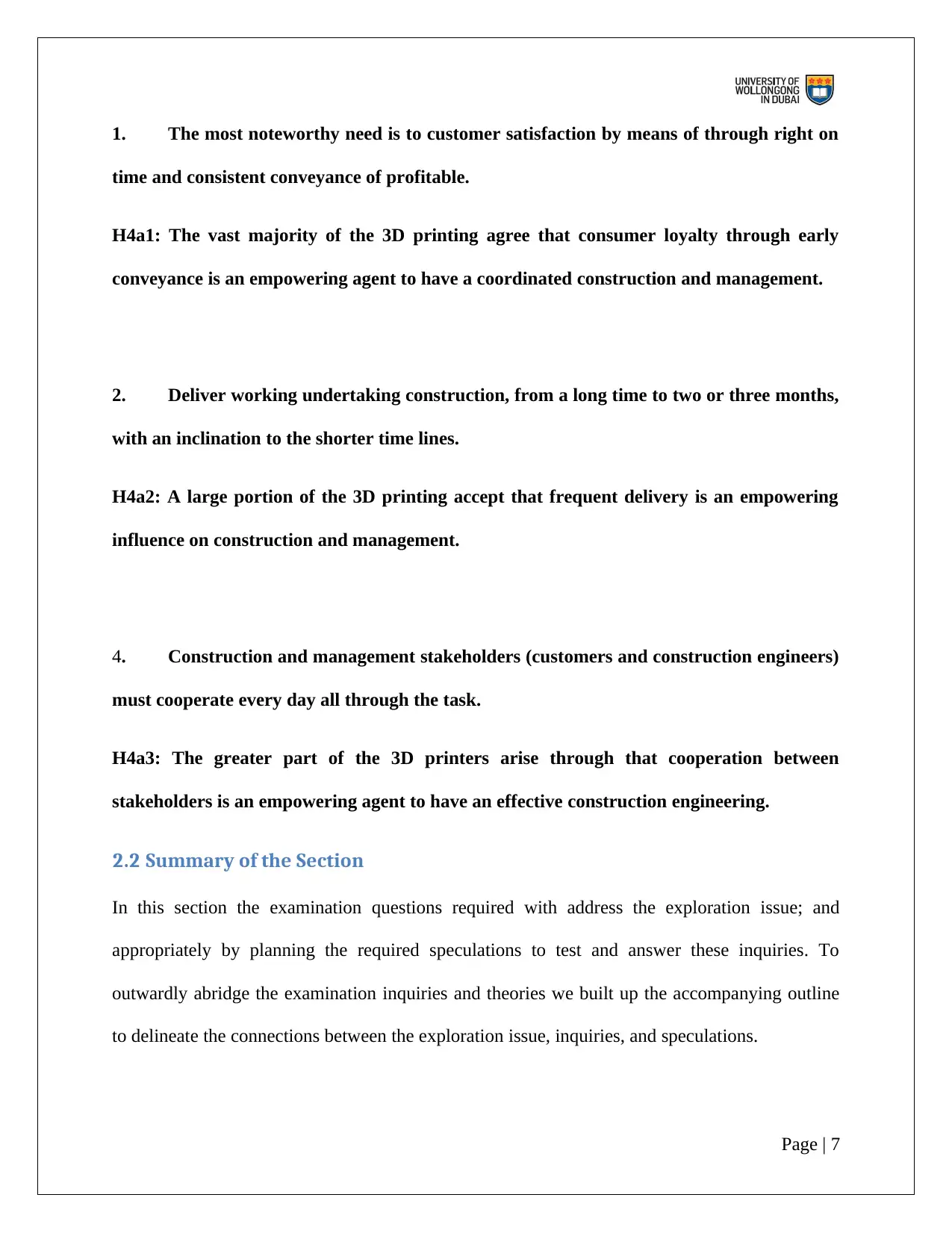
time and consistent conveyance of profitable.
H4a1: The vast majority of the 3D printing agree that consumer loyalty through early
conveyance is an empowering agent to have a coordinated construction and management.
2. Deliver working undertaking construction, from a long time to two or three months,
with an inclination to the shorter time lines.
H4a2: A large portion of the 3D printing accept that frequent delivery is an empowering
influence on construction and management.
4. Construction and management stakeholders (customers and construction engineers)
must cooperate every day all through the task.
H4a3: The greater part of the 3D printers arise through that cooperation between
stakeholders is an empowering agent to have an effective construction engineering.
2.2 Summary of the Section
In this section the examination questions required with address the exploration issue; and
appropriately by planning the required speculations to test and answer these inquiries. To
outwardly abridge the examination inquiries and theories we built up the accompanying outline
to delineate the connections between the exploration issue, inquiries, and speculations.
Page | 7
Paraphrase This Document

A questionnaire was designed keeping in mind the end goal to be circulated to the examination
populace test. To encourage a simple correspondence with the members the online questionnaire
tool from qualtrics.com was adopted (Appendix 1).
2.3.1 Target Populace Criteria
The objective populace was targeted to construction engineers, from the both genders, 18 years
of age or more, with no less than 1 years of involvement in construction and management.
2.3.2 Population Example Casing
The focused on test has been set to achieve 160+ from the above characterized target populace,
before the finish of the overview opening period (20 January 2018 till 15 April 2018) to get total
contributing 149 participants.
2.3.3 Questionnaire Correspondence
Keeping in mind the end goal to guarantee exact aftereffects of the survey, a watchful segment
procedure of the questionnaire participants needs to occur. Such cautious determination has been
accomplished by welcoming invitees who have demonstrated profiles that match the objective
populace criteria; this has been finished by auditing the profiles of the invitees on LinkedIn as a
standout amongst the most solid and endorsed proficient person to person communication media.
In the wake of evaluating the profile of the potential invitee and having a positive after-effect of
Page | 8
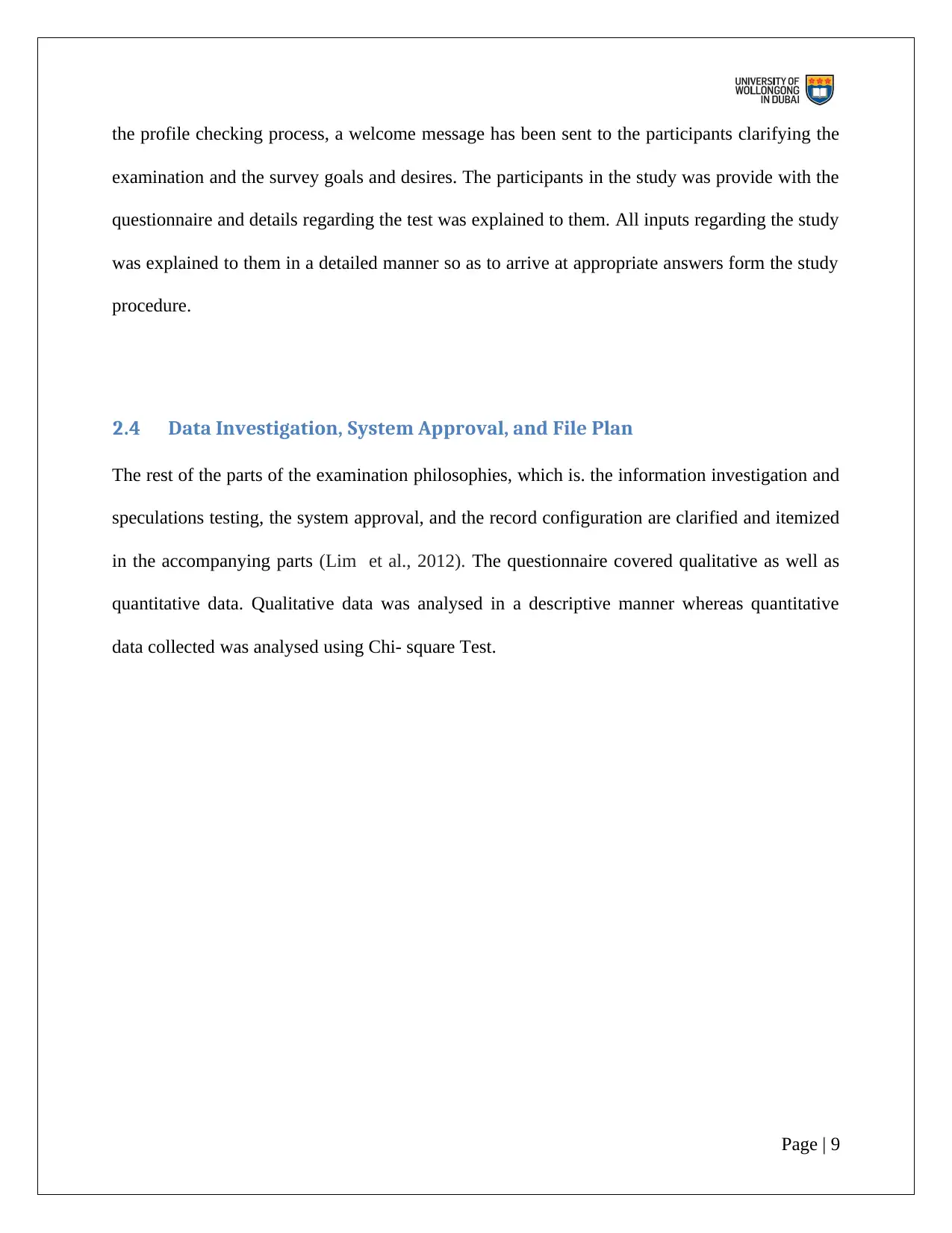
examination and the survey goals and desires. The participants in the study was provide with the
questionnaire and details regarding the test was explained to them. All inputs regarding the study
was explained to them in a detailed manner so as to arrive at appropriate answers form the study
procedure.
2.4 Data Investigation, System Approval, and File Plan
The rest of the parts of the examination philosophies, which is. the information investigation and
speculations testing, the system approval, and the record configuration are clarified and itemized
in the accompanying parts (Lim et al., 2012). The questionnaire covered qualitative as well as
quantitative data. Qualitative data was analysed in a descriptive manner whereas quantitative
data collected was analysed using Chi- square Test.
Page | 9
⊘ This is a preview!⊘
Do you want full access?
Subscribe today to unlock all pages.

Trusted by 1+ million students worldwide
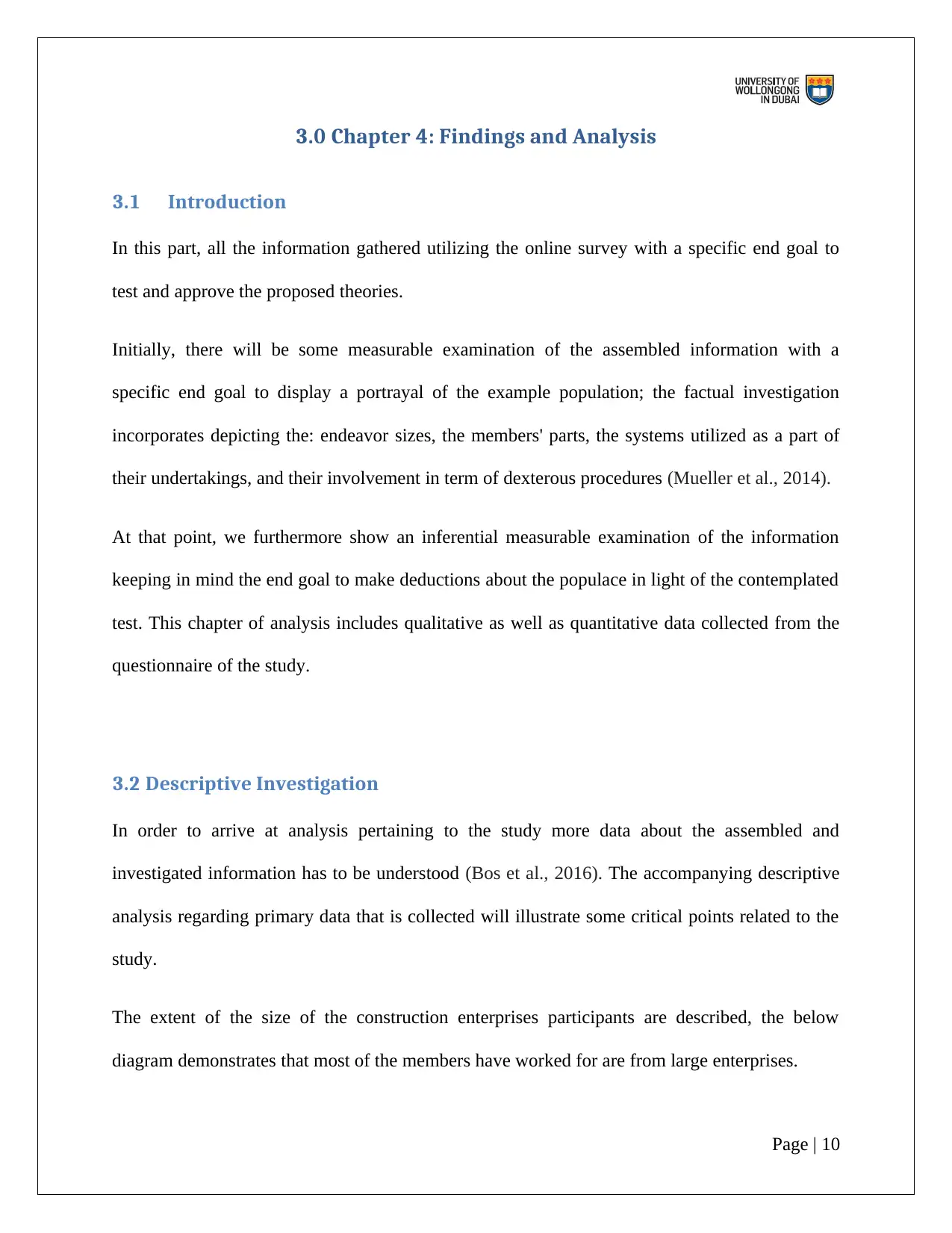
3.1 Introduction
In this part, all the information gathered utilizing the online survey with a specific end goal to
test and approve the proposed theories.
Initially, there will be some measurable examination of the assembled information with a
specific end goal to display a portrayal of the example population; the factual investigation
incorporates depicting the: endeavor sizes, the members' parts, the systems utilized as a part of
their undertakings, and their involvement in term of dexterous procedures (Mueller et al., 2014).
At that point, we furthermore show an inferential measurable examination of the information
keeping in mind the end goal to make deductions about the populace in light of the contemplated
test. This chapter of analysis includes qualitative as well as quantitative data collected from the
questionnaire of the study.
3.2 Descriptive Investigation
In order to arrive at analysis pertaining to the study more data about the assembled and
investigated information has to be understood (Bos et al., 2016). The accompanying descriptive
analysis regarding primary data that is collected will illustrate some critical points related to the
study.
The extent of the size of the construction enterprises participants are described, the below
diagram demonstrates that most of the members have worked for are from large enterprises.
Page | 10
Paraphrase This Document

Construction
Firms
41%
Mid-ranged Construction
Firms
26%
Small Construction
Firms
9%
Others
24%
Construction Enterprise Size
Figure 1: Participants Enterprise Sizes
While analysing roles of participants who provided their feedback, most of them were believed
to be designers using 3D printers, as designing consists of most integral aspect.
Page | 11
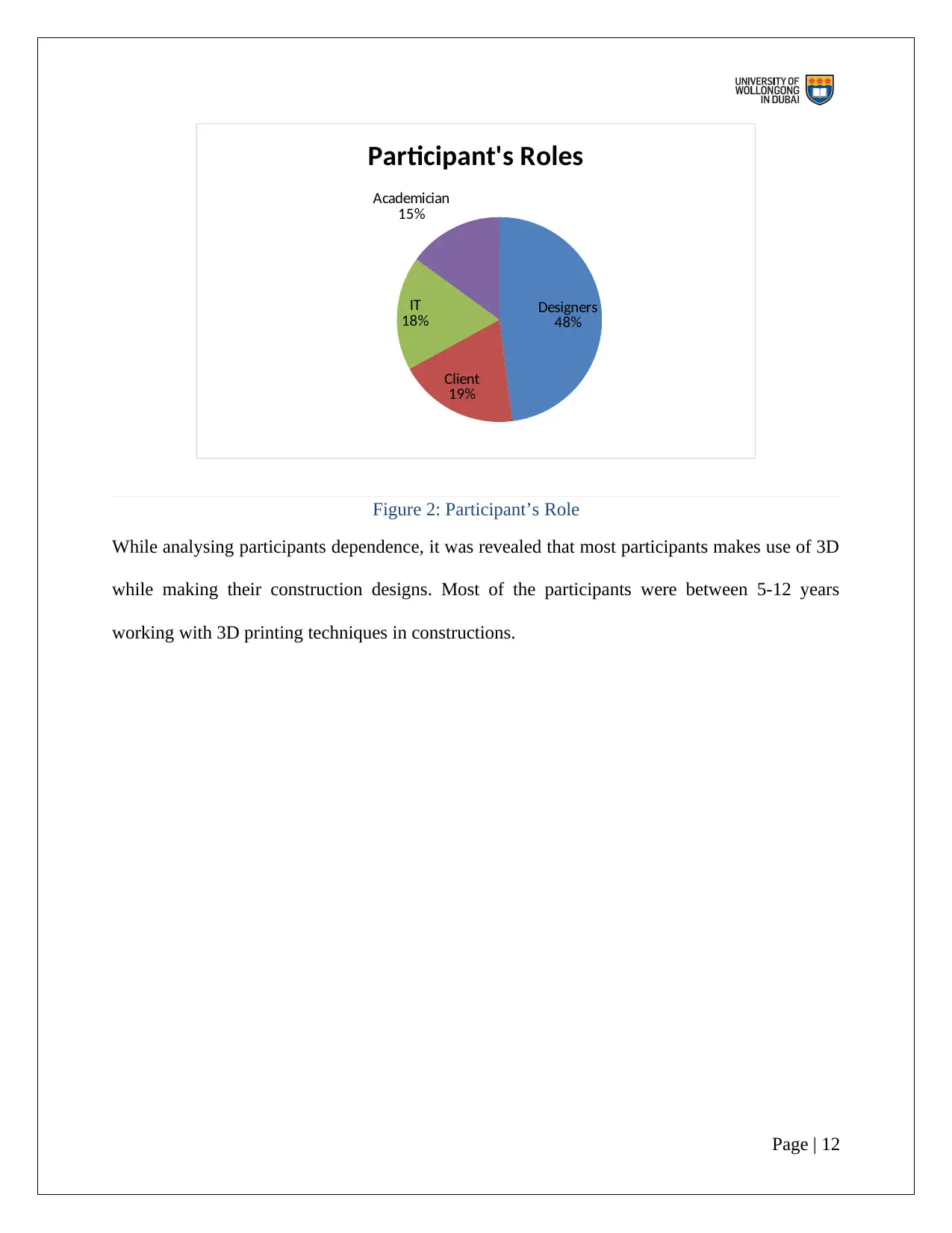
48%
Client
19%
IT
18%
Academician
15%
Participant's Roles
Figure 2: Participant’s Role
While analysing participants dependence, it was revealed that most participants makes use of 3D
while making their construction designs. Most of the participants were between 5-12 years
working with 3D printing techniques in constructions.
Page | 12
⊘ This is a preview!⊘
Do you want full access?
Subscribe today to unlock all pages.

Trusted by 1+ million students worldwide
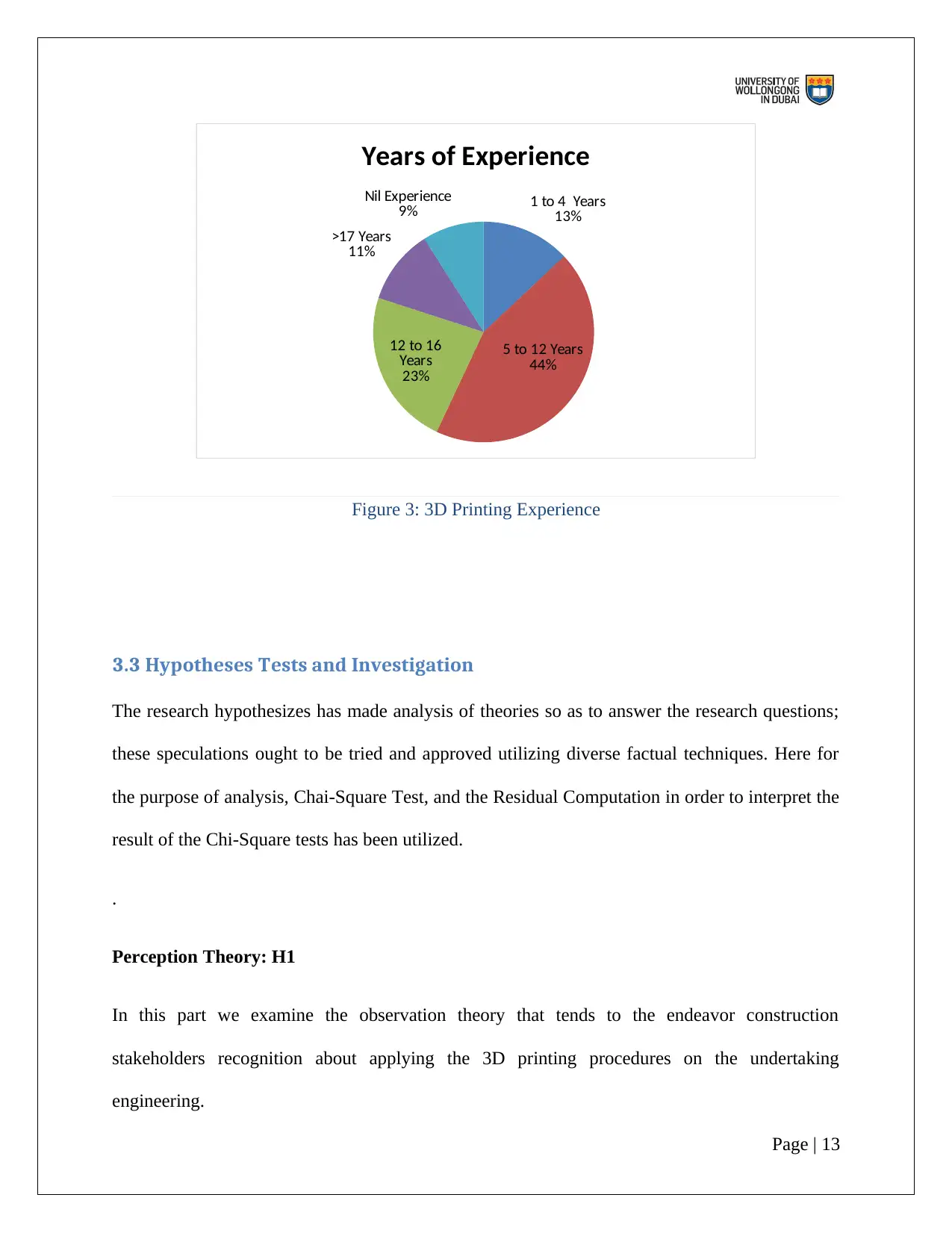
13%
5 to 12 Years
44%
12 to 16
Years
23%
>17 Years
11%
Nil Experience
9%
Years of Experience
Figure 3: 3D Printing Experience
3.3 Hypotheses Tests and Investigation
The research hypothesizes has made analysis of theories so as to answer the research questions;
these speculations ought to be tried and approved utilizing diverse factual techniques. Here for
the purpose of analysis, Chai-Square Test, and the Residual Computation in order to interpret the
result of the Chi-Square tests has been utilized.
.
Perception Theory: H1
In this part we examine the observation theory that tends to the endeavor construction
stakeholders recognition about applying the 3D printing procedures on the undertaking
engineering.
Page | 13
Paraphrase This Document
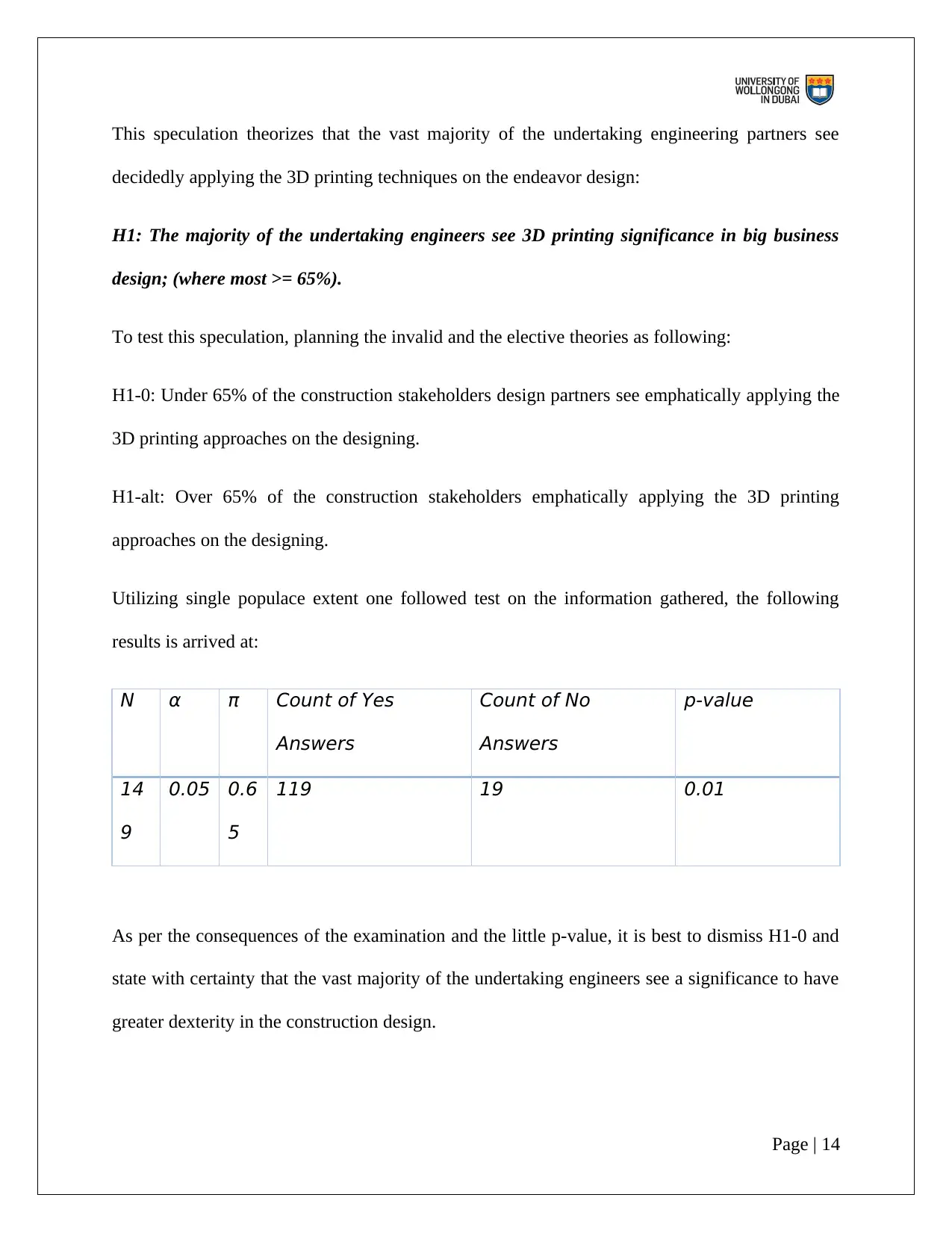
decidedly applying the 3D printing techniques on the endeavor design:
H1: The majority of the undertaking engineers see 3D printing significance in big business
design; (where most >= 65%).
To test this speculation, planning the invalid and the elective theories as following:
H1-0: Under 65% of the construction stakeholders design partners see emphatically applying the
3D printing approaches on the designing.
H1-alt: Over 65% of the construction stakeholders emphatically applying the 3D printing
approaches on the designing.
Utilizing single populace extent one followed test on the information gathered, the following
results is arrived at:
N α π Count of Yes
Answers
Count of No
Answers
p-value
14
9
0.05 0.6
5
119 19 0.01
As per the consequences of the examination and the little p-value, it is best to dismiss H1-0 and
state with certainty that the vast majority of the undertaking engineers see a significance to have
greater dexterity in the construction design.
Page | 14
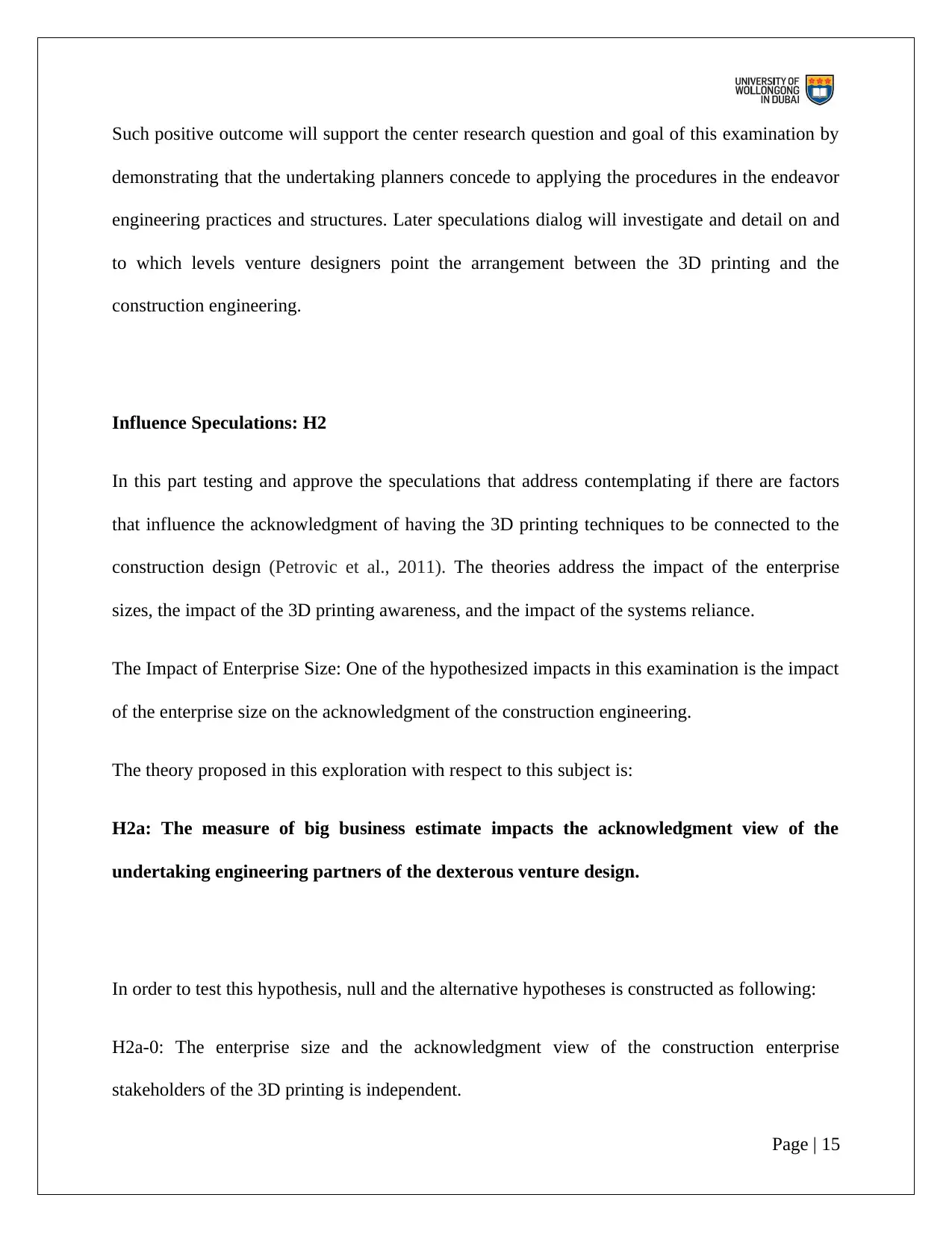
demonstrating that the undertaking planners concede to applying the procedures in the endeavor
engineering practices and structures. Later speculations dialog will investigate and detail on and
to which levels venture designers point the arrangement between the 3D printing and the
construction engineering.
Influence Speculations: H2
In this part testing and approve the speculations that address contemplating if there are factors
that influence the acknowledgment of having the 3D printing techniques to be connected to the
construction design (Petrovic et al., 2011). The theories address the impact of the enterprise
sizes, the impact of the 3D printing awareness, and the impact of the systems reliance.
The Impact of Enterprise Size: One of the hypothesized impacts in this examination is the impact
of the enterprise size on the acknowledgment of the construction engineering.
The theory proposed in this exploration with respect to this subject is:
H2a: The measure of big business estimate impacts the acknowledgment view of the
undertaking engineering partners of the dexterous venture design.
In order to test this hypothesis, null and the alternative hypotheses is constructed as following:
H2a-0: The enterprise size and the acknowledgment view of the construction enterprise
stakeholders of the 3D printing is independent.
Page | 15
⊘ This is a preview!⊘
Do you want full access?
Subscribe today to unlock all pages.

Trusted by 1+ million students worldwide
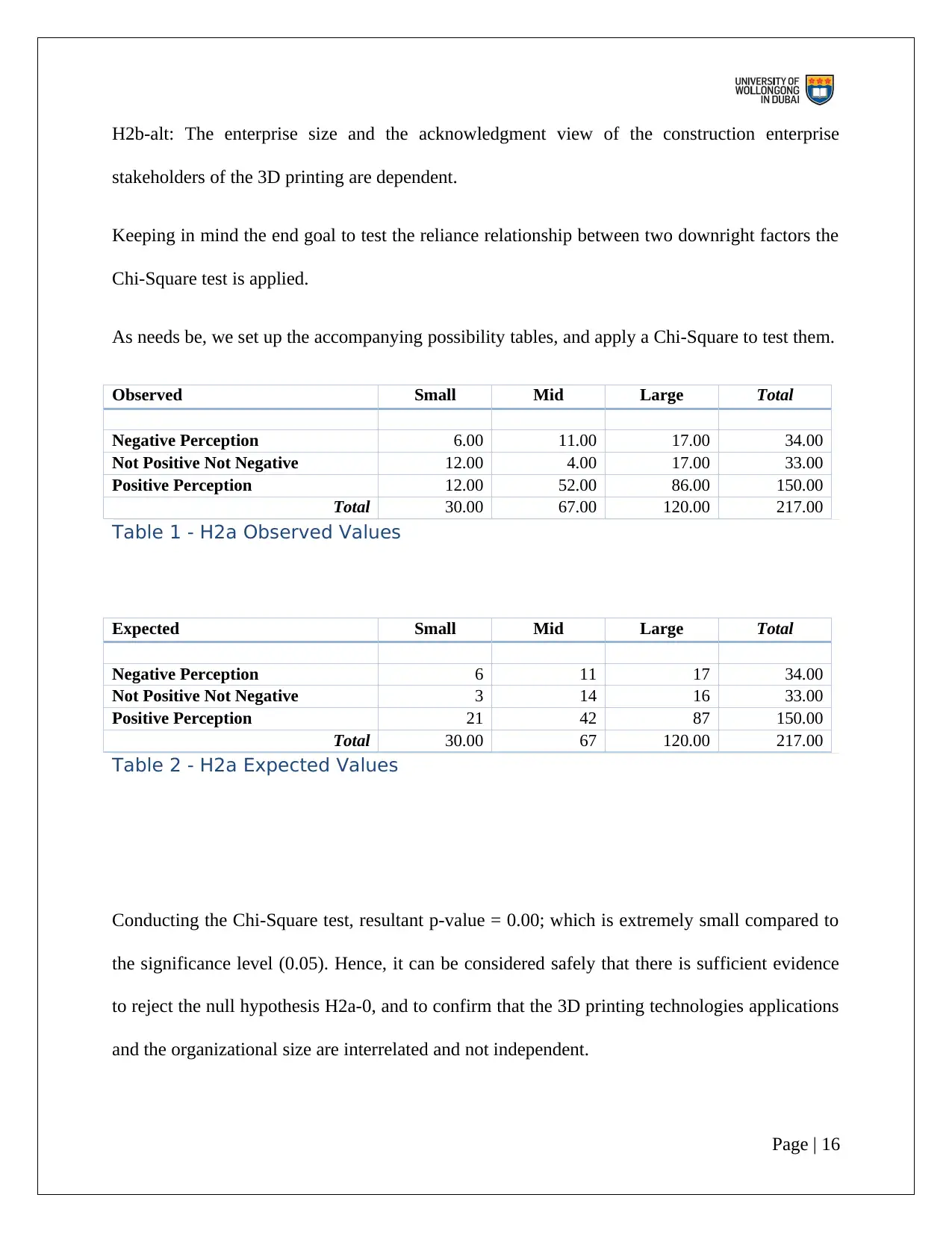
stakeholders of the 3D printing are dependent.
Keeping in mind the end goal to test the reliance relationship between two downright factors the
Chi-Square test is applied.
As needs be, we set up the accompanying possibility tables, and apply a Chi-Square to test them.
Observed Small Mid Large Total
Negative Perception 6.00 11.00 17.00 34.00
Not Positive Not Negative 12.00 4.00 17.00 33.00
Positive Perception 12.00 52.00 86.00 150.00
Total 30.00 67.00 120.00 217.00
Table 1 - H2a Observed Values
Expected Small Mid Large Total
Negative Perception 6 11 17 34.00
Not Positive Not Negative 3 14 16 33.00
Positive Perception 21 42 87 150.00
Total 30.00 67 120.00 217.00
Table 2 - H2a Expected Values
Conducting the Chi-Square test, resultant p-value = 0.00; which is extremely small compared to
the significance level (0.05). Hence, it can be considered safely that there is sufficient evidence
to reject the null hypothesis H2a-0, and to confirm that the 3D printing technologies applications
and the organizational size are interrelated and not independent.
Page | 16
Paraphrase This Document
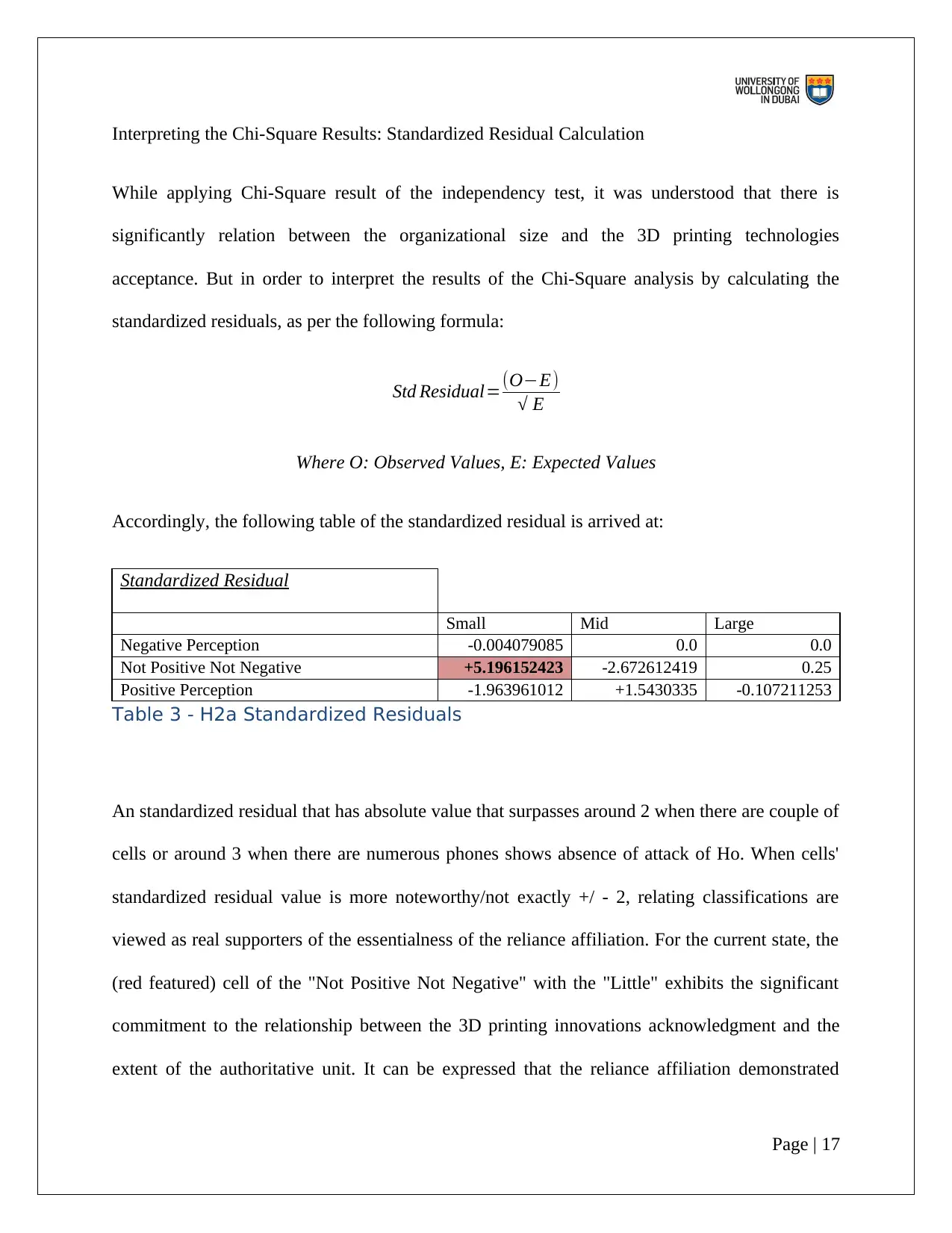
While applying Chi-Square result of the independency test, it was understood that there is
significantly relation between the organizational size and the 3D printing technologies
acceptance. But in order to interpret the results of the Chi-Square analysis by calculating the
standardized residuals, as per the following formula:
Std Residual=(O−E)
√ E
Where O: Observed Values, E: Expected Values
Accordingly, the following table of the standardized residual is arrived at:
Standardized Residual
Small Mid Large
Negative Perception -0.004079085 0.0 0.0
Not Positive Not Negative +5.196152423 -2.672612419 0.25
Positive Perception -1.963961012 +1.5430335 -0.107211253
Table 3 - H2a Standardized Residuals
An standardized residual that has absolute value that surpasses around 2 when there are couple of
cells or around 3 when there are numerous phones shows absence of attack of Ho. When cells'
standardized residual value is more noteworthy/not exactly +/ - 2, relating classifications are
viewed as real supporters of the essentialness of the reliance affiliation. For the current state, the
(red featured) cell of the "Not Positive Not Negative" with the "Little" exhibits the significant
commitment to the relationship between the 3D printing innovations acknowledgment and the
extent of the authoritative unit. It can be expressed that the reliance affiliation demonstrated
Page | 17

venture engineering partners have a tendency to have no inclination toward the 3D printing
advancements and reply with the appropriate response "Not Positive Not Negative".
It is very critical to see that this outcome underpins our past about the positive view of the
undertaking engineering partner, as we understood that the hierarchical size influences the
members who answered with unbiased recognition "Not Positive Not Negative"; realizing that
these member's answers are rejected from the measurements trial of the observation question
bolsters our outcomes as it is identified with the ordinarily dispersed reactions, i.e. the non-
influenced members.
The Influence of 3D printing Awareness
Do 3D printing techniques-aware enterprise architecture stakeholders perceive more positive
perception about accepting the 3D printing techniques methodologies application on the
enterprise architecture practices and frameworks compared to those with less or no 3D printing
techniques methodologies awareness?
H2b: The awareness of the agility methodologies influences the acceptance perception of
the 3D printing technologies for the enterprise architects.
To test this hypothesis, formulating the null and the alternative hypotheses has to be attempted as
following:
H2b-0: The awareness of the agility methodologies and the acceptance perception of the
enterprise architecture stakeholders of the 3D printing technologies are independent.
Page | 18
⊘ This is a preview!⊘
Do you want full access?
Subscribe today to unlock all pages.

Trusted by 1+ million students worldwide
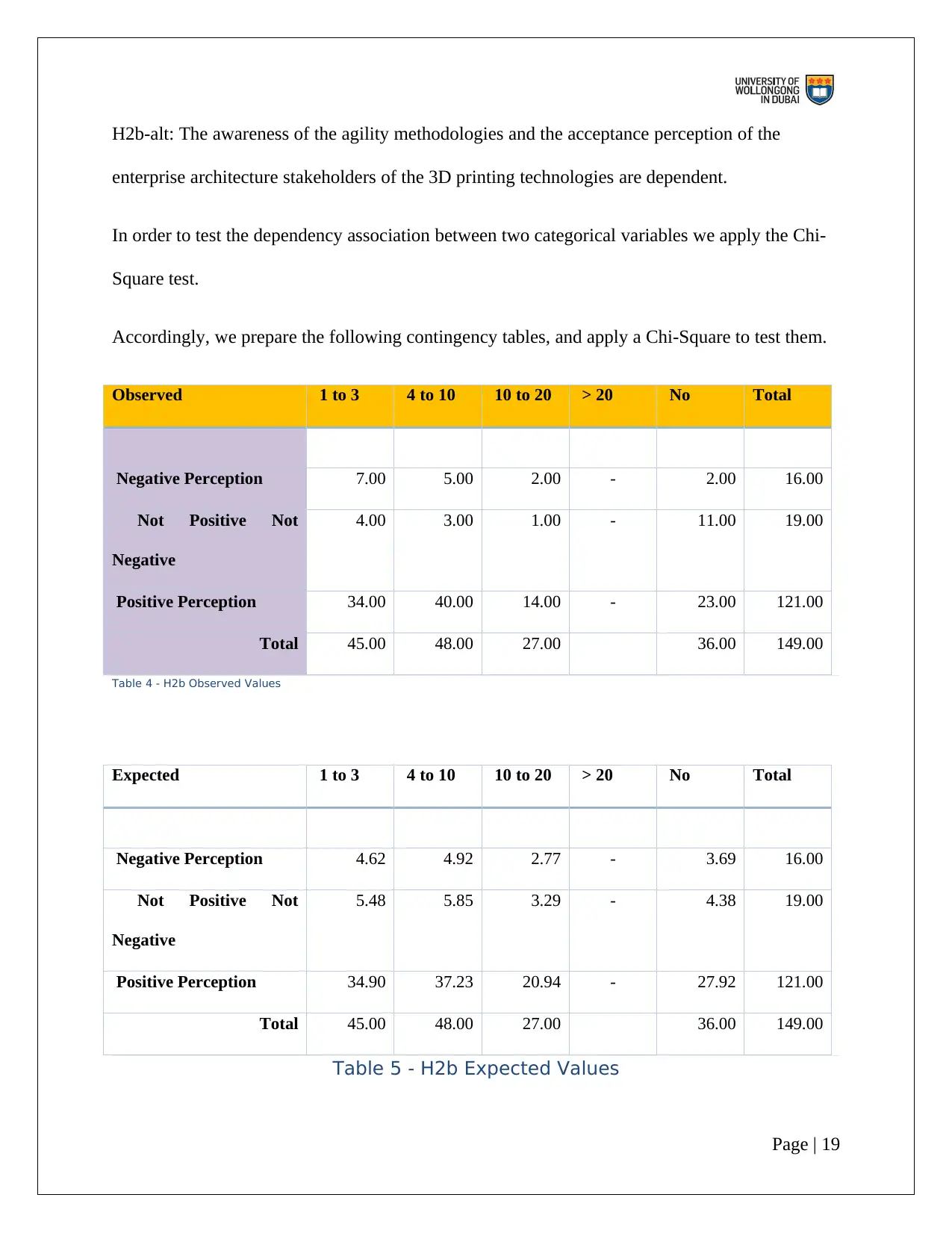
enterprise architecture stakeholders of the 3D printing technologies are dependent.
In order to test the dependency association between two categorical variables we apply the Chi-
Square test.
Accordingly, we prepare the following contingency tables, and apply a Chi-Square to test them.
Observed 1 to 3 4 to 10 10 to 20 > 20 No Total
Negative Perception 7.00 5.00 2.00 - 2.00 16.00
Not Positive Not
Negative
4.00 3.00 1.00 - 11.00 19.00
Positive Perception 34.00 40.00 14.00 - 23.00 121.00
Total 45.00 48.00 27.00 36.00 149.00
Table 4 - H2b Observed Values
Expected 1 to 3 4 to 10 10 to 20 > 20 No Total
Negative Perception 4.62 4.92 2.77 - 3.69 16.00
Not Positive Not
Negative
5.48 5.85 3.29 - 4.38 19.00
Positive Perception 34.90 37.23 20.94 - 27.92 121.00
Total 45.00 48.00 27.00 36.00 149.00
Table 5 - H2b Expected Values
Page | 19
Paraphrase This Document
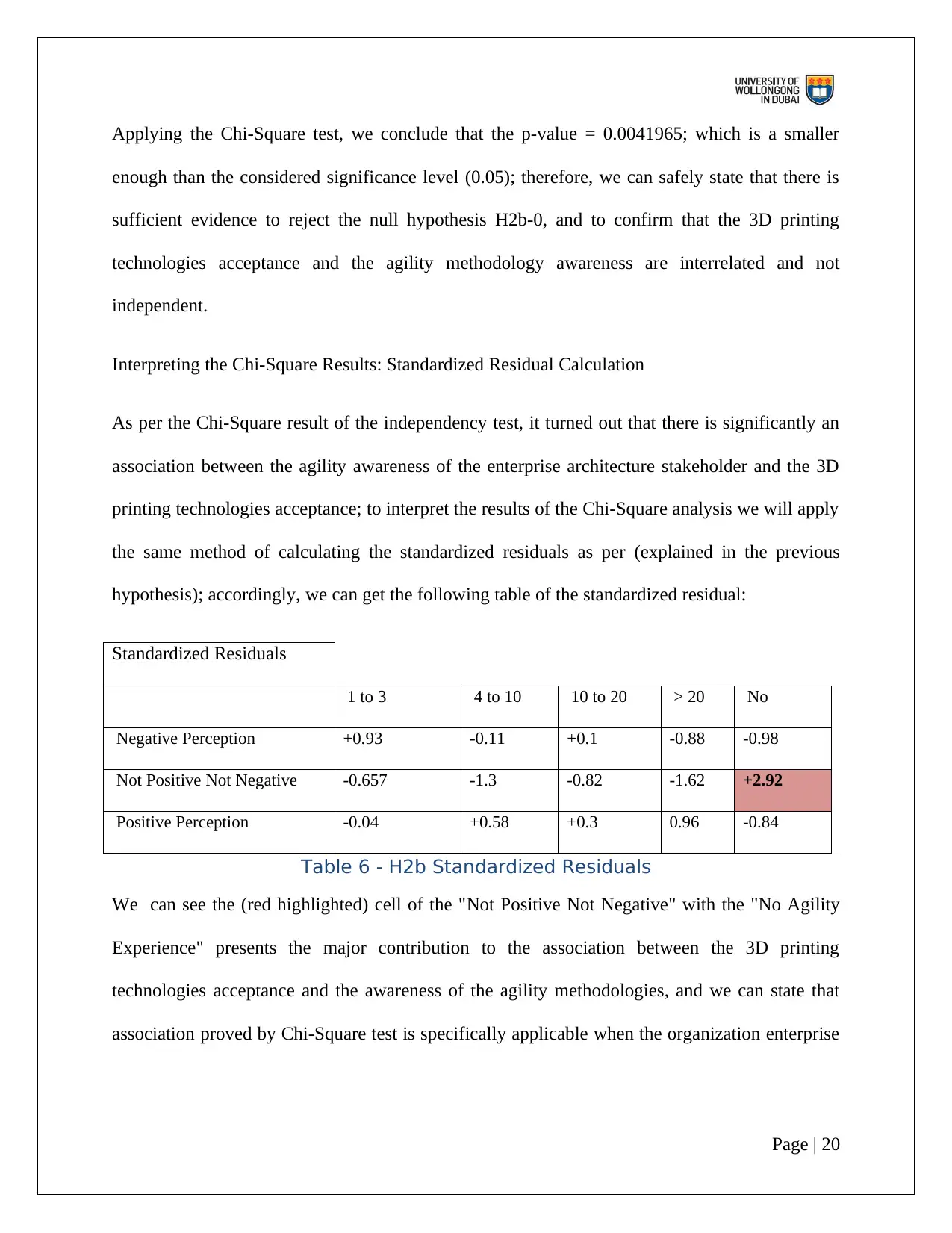
enough than the considered significance level (0.05); therefore, we can safely state that there is
sufficient evidence to reject the null hypothesis H2b-0, and to confirm that the 3D printing
technologies acceptance and the agility methodology awareness are interrelated and not
independent.
Interpreting the Chi-Square Results: Standardized Residual Calculation
As per the Chi-Square result of the independency test, it turned out that there is significantly an
association between the agility awareness of the enterprise architecture stakeholder and the 3D
printing technologies acceptance; to interpret the results of the Chi-Square analysis we will apply
the same method of calculating the standardized residuals as per (explained in the previous
hypothesis); accordingly, we can get the following table of the standardized residual:
Standardized Residuals
1 to 3 4 to 10 10 to 20 > 20 No
Negative Perception +0.93 -0.11 +0.1 -0.88 -0.98
Not Positive Not Negative -0.657 -1.3 -0.82 -1.62 +2.92
Positive Perception -0.04 +0.58 +0.3 0.96 -0.84
Table 6 - H2b Standardized Residuals
We can see the (red highlighted) cell of the "Not Positive Not Negative" with the "No Agility
Experience" presents the major contribution to the association between the 3D printing
technologies acceptance and the awareness of the agility methodologies, and we can state that
association proved by Chi-Square test is specifically applicable when the organization enterprise
Page | 20
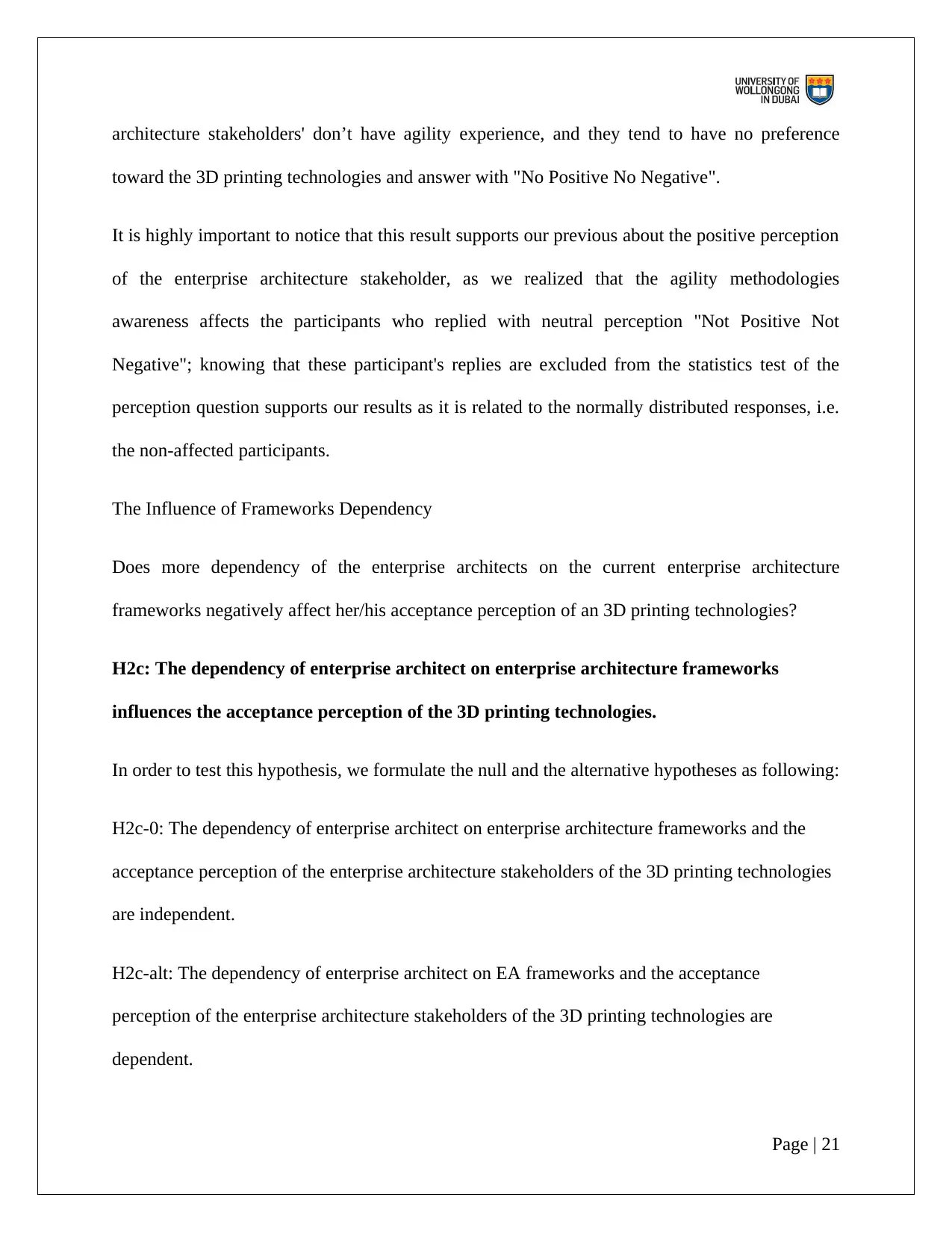
toward the 3D printing technologies and answer with "No Positive No Negative".
It is highly important to notice that this result supports our previous about the positive perception
of the enterprise architecture stakeholder, as we realized that the agility methodologies
awareness affects the participants who replied with neutral perception "Not Positive Not
Negative"; knowing that these participant's replies are excluded from the statistics test of the
perception question supports our results as it is related to the normally distributed responses, i.e.
the non-affected participants.
The Influence of Frameworks Dependency
Does more dependency of the enterprise architects on the current enterprise architecture
frameworks negatively affect her/his acceptance perception of an 3D printing technologies?
H2c: The dependency of enterprise architect on enterprise architecture frameworks
influences the acceptance perception of the 3D printing technologies.
In order to test this hypothesis, we formulate the null and the alternative hypotheses as following:
H2c-0: The dependency of enterprise architect on enterprise architecture frameworks and the
acceptance perception of the enterprise architecture stakeholders of the 3D printing technologies
are independent.
H2c-alt: The dependency of enterprise architect on EA frameworks and the acceptance
perception of the enterprise architecture stakeholders of the 3D printing technologies are
dependent.
Page | 21
⊘ This is a preview!⊘
Do you want full access?
Subscribe today to unlock all pages.

Trusted by 1+ million students worldwide
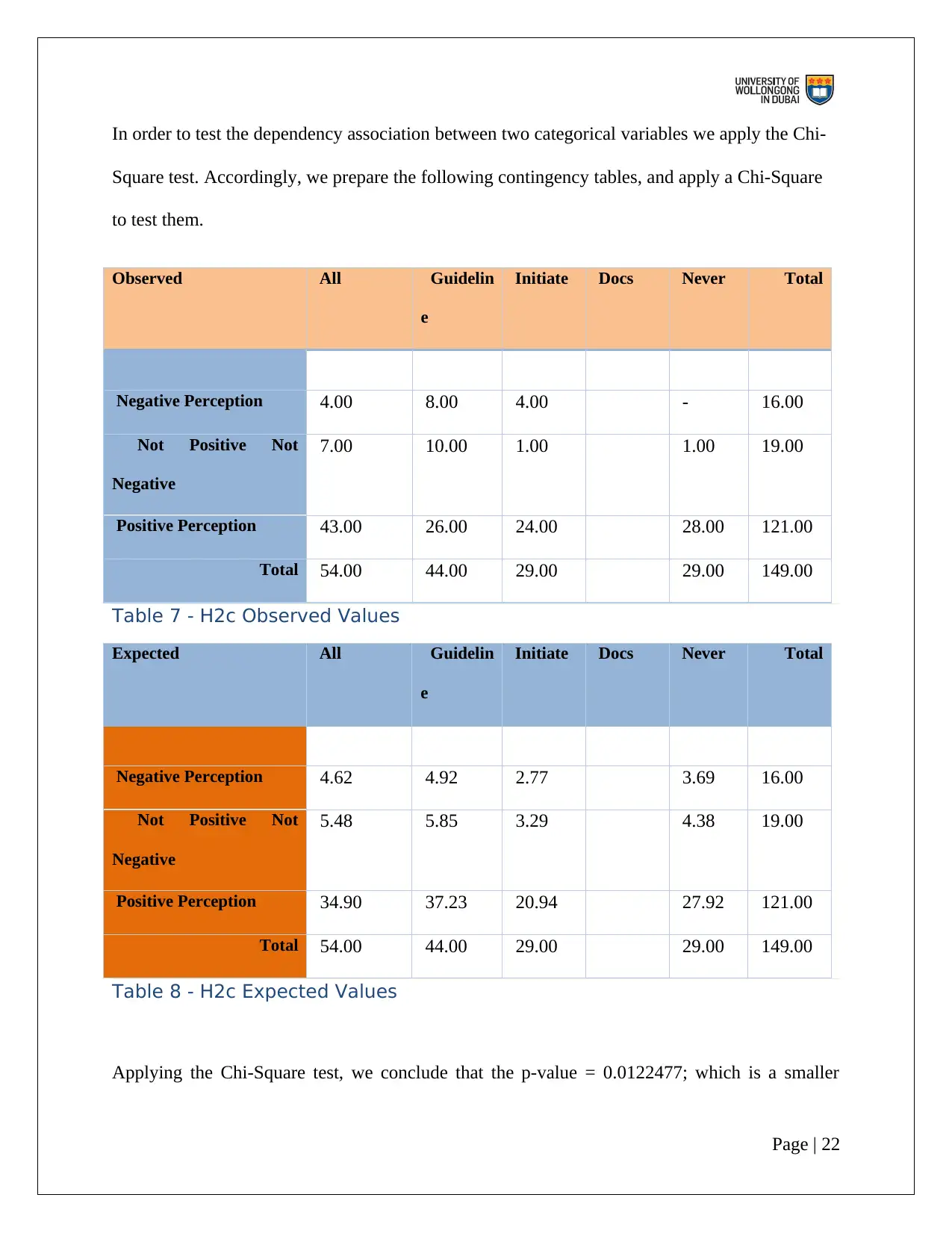
Square test. Accordingly, we prepare the following contingency tables, and apply a Chi-Square
to test them.
Observed All Guidelin
e
Initiate Docs Never Total
Negative Perception 4.00 8.00 4.00 - 16.00
Not Positive Not
Negative
7.00 10.00 1.00 1.00 19.00
Positive Perception 43.00 26.00 24.00 28.00 121.00
Total 54.00 44.00 29.00 29.00 149.00
Table 7 - H2c Observed Values
Expected All Guidelin
e
Initiate Docs Never Total
Negative Perception 4.62 4.92 2.77 3.69 16.00
Not Positive Not
Negative
5.48 5.85 3.29 4.38 19.00
Positive Perception 34.90 37.23 20.94 27.92 121.00
Total 54.00 44.00 29.00 29.00 149.00
Table 8 - H2c Expected Values
Applying the Chi-Square test, we conclude that the p-value = 0.0122477; which is a smaller
Page | 22
Paraphrase This Document
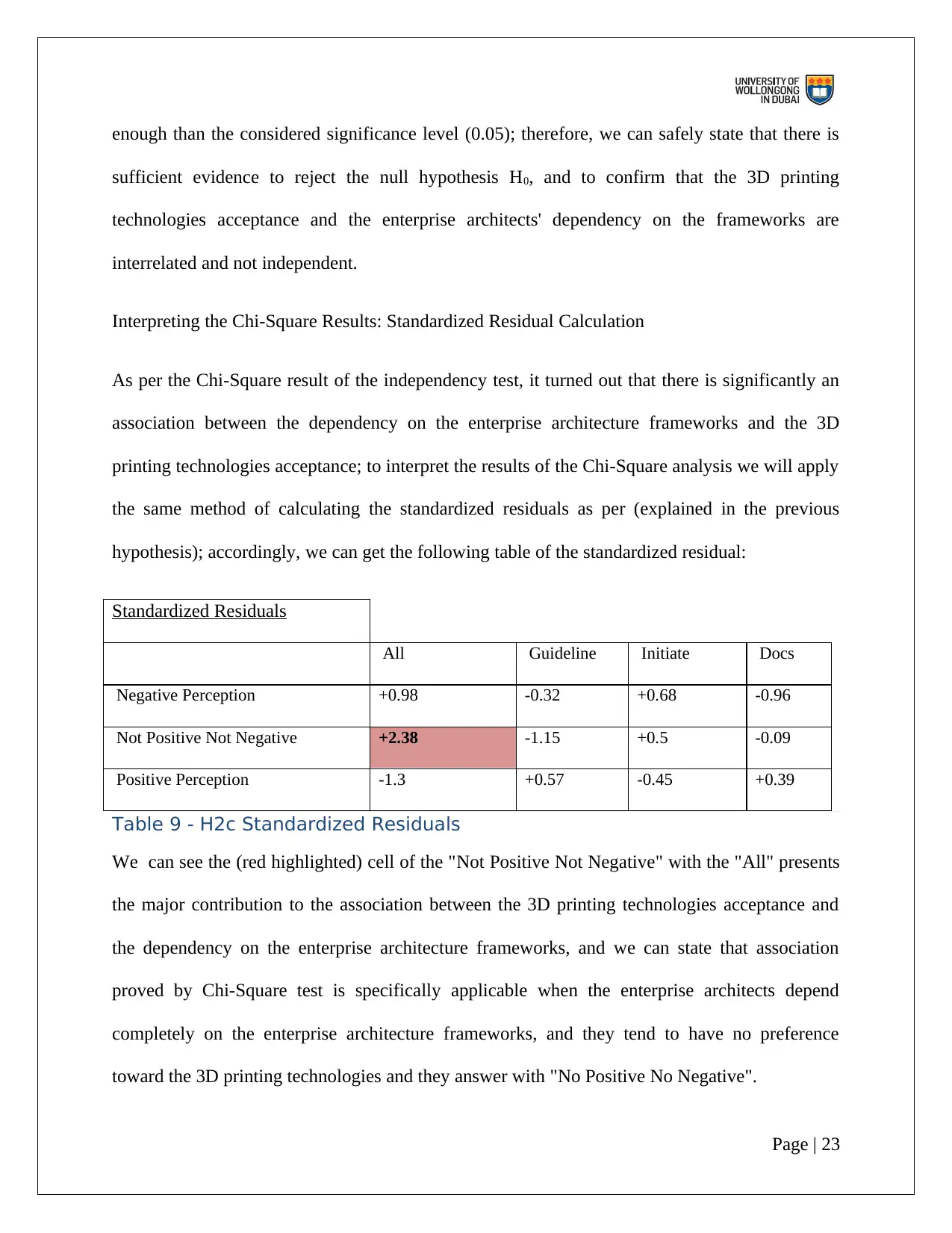
sufficient evidence to reject the null hypothesis H0, and to confirm that the 3D printing
technologies acceptance and the enterprise architects' dependency on the frameworks are
interrelated and not independent.
Interpreting the Chi-Square Results: Standardized Residual Calculation
As per the Chi-Square result of the independency test, it turned out that there is significantly an
association between the dependency on the enterprise architecture frameworks and the 3D
printing technologies acceptance; to interpret the results of the Chi-Square analysis we will apply
the same method of calculating the standardized residuals as per (explained in the previous
hypothesis); accordingly, we can get the following table of the standardized residual:
Standardized Residuals
All Guideline Initiate Docs
Negative Perception +0.98 -0.32 +0.68 -0.96
Not Positive Not Negative +2.38 -1.15 +0.5 -0.09
Positive Perception -1.3 +0.57 -0.45 +0.39
Table 9 - H2c Standardized Residuals
We can see the (red highlighted) cell of the "Not Positive Not Negative" with the "All" presents
the major contribution to the association between the 3D printing technologies acceptance and
the dependency on the enterprise architecture frameworks, and we can state that association
proved by Chi-Square test is specifically applicable when the enterprise architects depend
completely on the enterprise architecture frameworks, and they tend to have no preference
toward the 3D printing technologies and they answer with "No Positive No Negative".
Page | 23
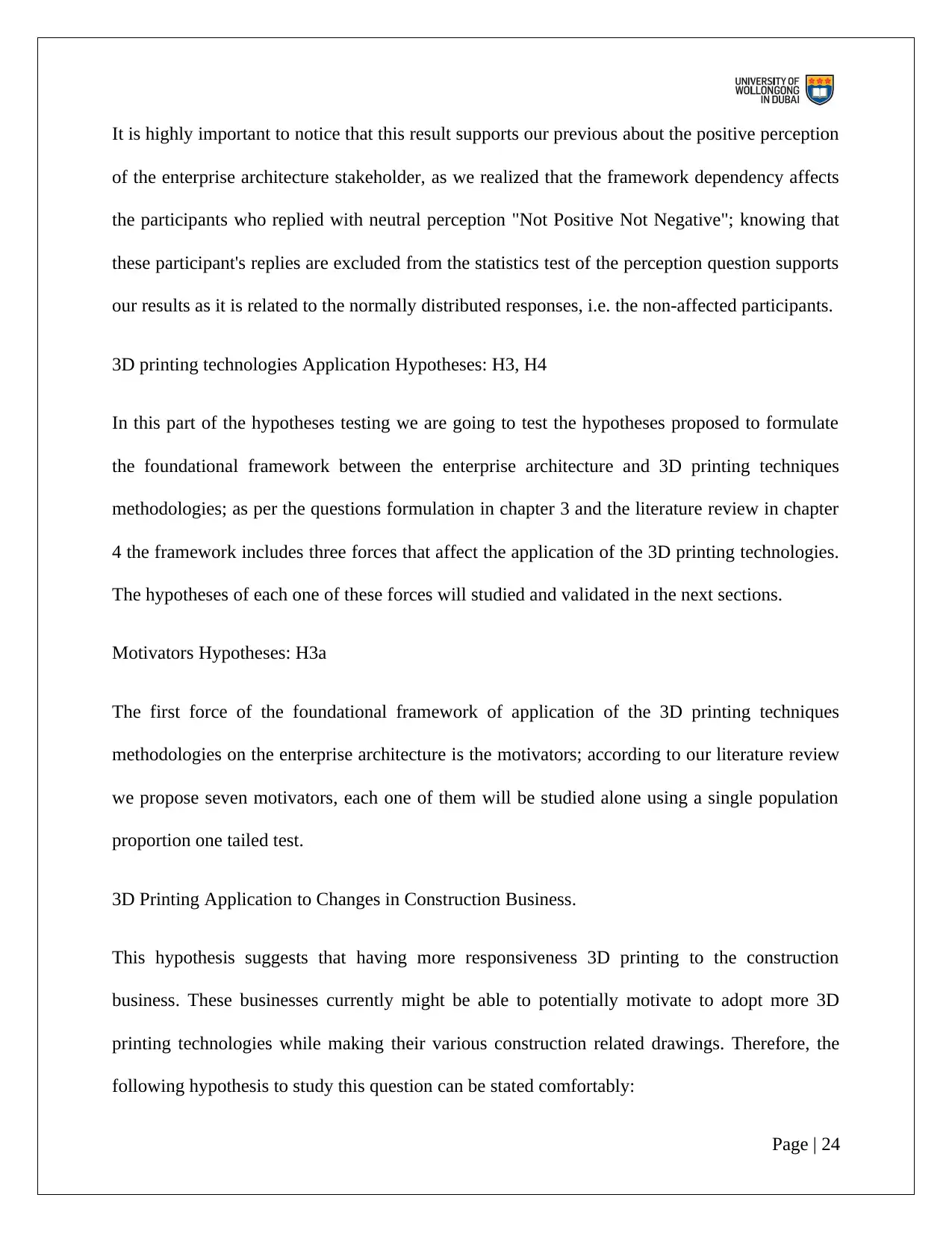
of the enterprise architecture stakeholder, as we realized that the framework dependency affects
the participants who replied with neutral perception "Not Positive Not Negative"; knowing that
these participant's replies are excluded from the statistics test of the perception question supports
our results as it is related to the normally distributed responses, i.e. the non-affected participants.
3D printing technologies Application Hypotheses: H3, H4
In this part of the hypotheses testing we are going to test the hypotheses proposed to formulate
the foundational framework between the enterprise architecture and 3D printing techniques
methodologies; as per the questions formulation in chapter 3 and the literature review in chapter
4 the framework includes three forces that affect the application of the 3D printing technologies.
The hypotheses of each one of these forces will studied and validated in the next sections.
Motivators Hypotheses: H3a
The first force of the foundational framework of application of the 3D printing techniques
methodologies on the enterprise architecture is the motivators; according to our literature review
we propose seven motivators, each one of them will be studied alone using a single population
proportion one tailed test.
3D Printing Application to Changes in Construction Business.
This hypothesis suggests that having more responsiveness 3D printing to the construction
business. These businesses currently might be able to potentially motivate to adopt more 3D
printing technologies while making their various construction related drawings. Therefore, the
following hypothesis to study this question can be stated comfortably:
Page | 24
⊘ This is a preview!⊘
Do you want full access?
Subscribe today to unlock all pages.

Trusted by 1+ million students worldwide
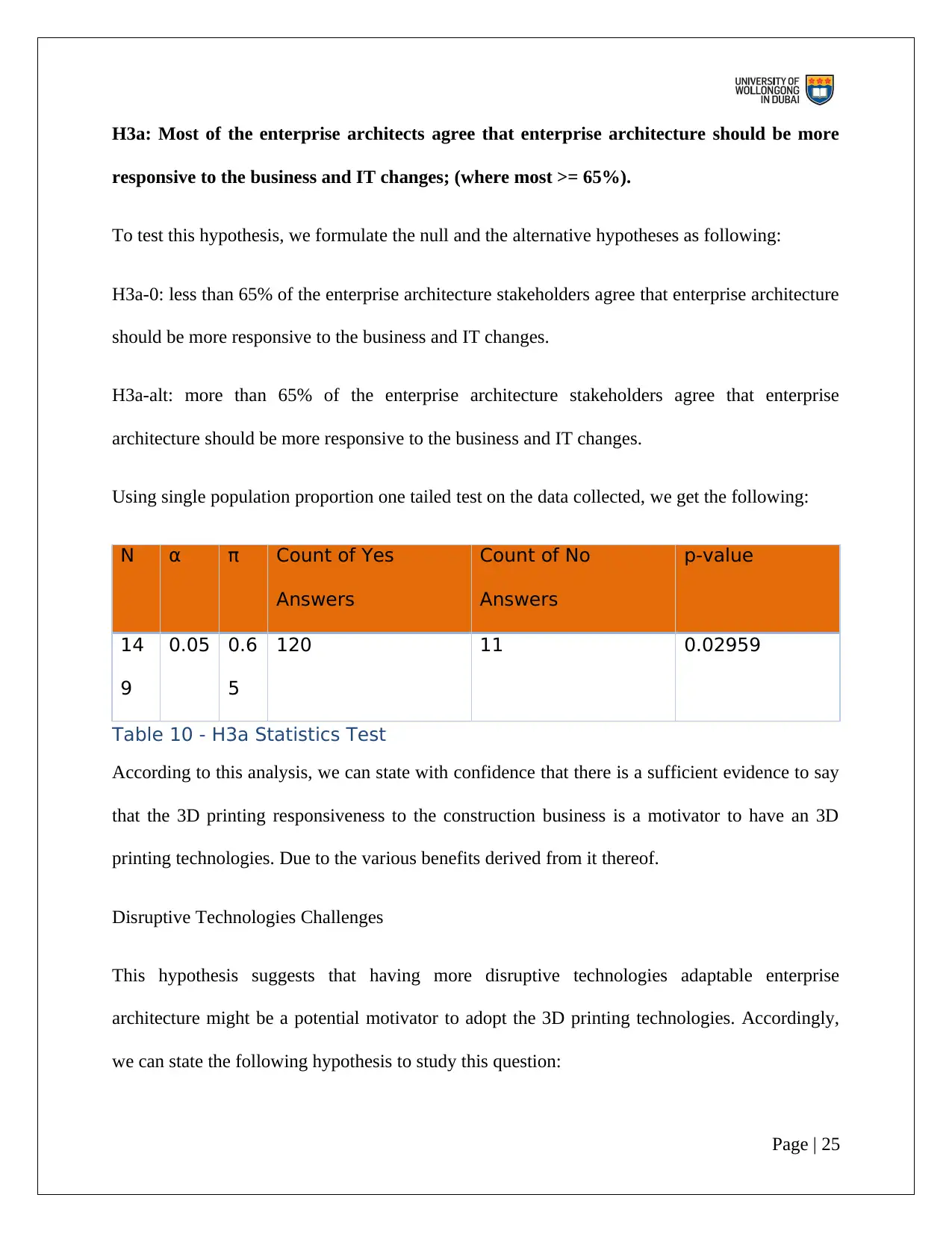
responsive to the business and IT changes; (where most >= 65%).
To test this hypothesis, we formulate the null and the alternative hypotheses as following:
H3a-0: less than 65% of the enterprise architecture stakeholders agree that enterprise architecture
should be more responsive to the business and IT changes.
H3a-alt: more than 65% of the enterprise architecture stakeholders agree that enterprise
architecture should be more responsive to the business and IT changes.
Using single population proportion one tailed test on the data collected, we get the following:
N α π Count of Yes
Answers
Count of No
Answers
p-value
14
9
0.05 0.6
5
120 11 0.02959
Table 10 - H3a Statistics Test
According to this analysis, we can state with confidence that there is a sufficient evidence to say
that the 3D printing responsiveness to the construction business is a motivator to have an 3D
printing technologies. Due to the various benefits derived from it thereof.
Disruptive Technologies Challenges
This hypothesis suggests that having more disruptive technologies adaptable enterprise
architecture might be a potential motivator to adopt the 3D printing technologies. Accordingly,
we can state the following hypothesis to study this question:
Page | 25
Paraphrase This Document
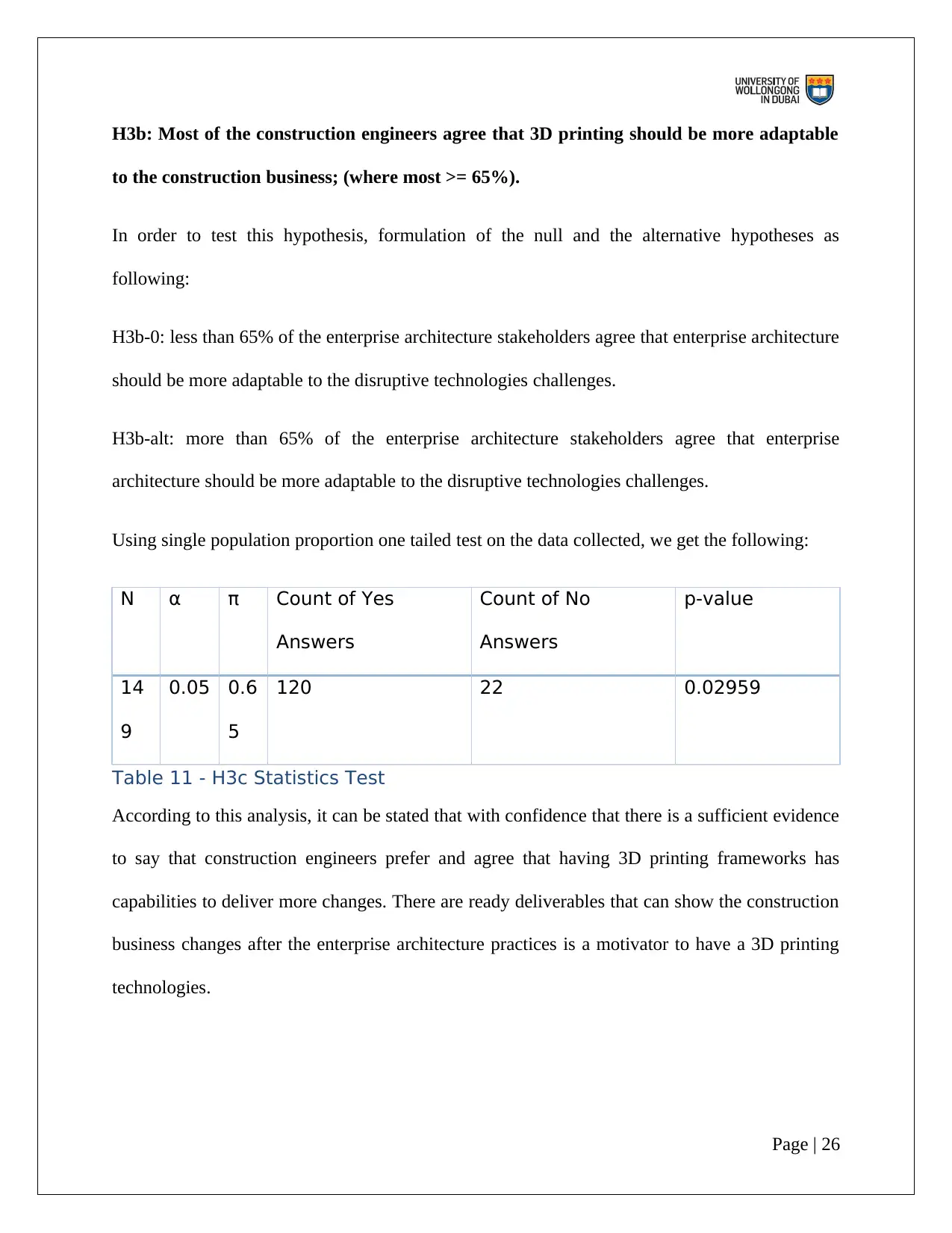
to the construction business; (where most >= 65%).
In order to test this hypothesis, formulation of the null and the alternative hypotheses as
following:
H3b-0: less than 65% of the enterprise architecture stakeholders agree that enterprise architecture
should be more adaptable to the disruptive technologies challenges.
H3b-alt: more than 65% of the enterprise architecture stakeholders agree that enterprise
architecture should be more adaptable to the disruptive technologies challenges.
Using single population proportion one tailed test on the data collected, we get the following:
N α π Count of Yes
Answers
Count of No
Answers
p-value
14
9
0.05 0.6
5
120 22 0.02959
Table 11 - H3c Statistics Test
According to this analysis, it can be stated that with confidence that there is a sufficient evidence
to say that construction engineers prefer and agree that having 3D printing frameworks has
capabilities to deliver more changes. There are ready deliverables that can show the construction
business changes after the enterprise architecture practices is a motivator to have a 3D printing
technologies.
Page | 26
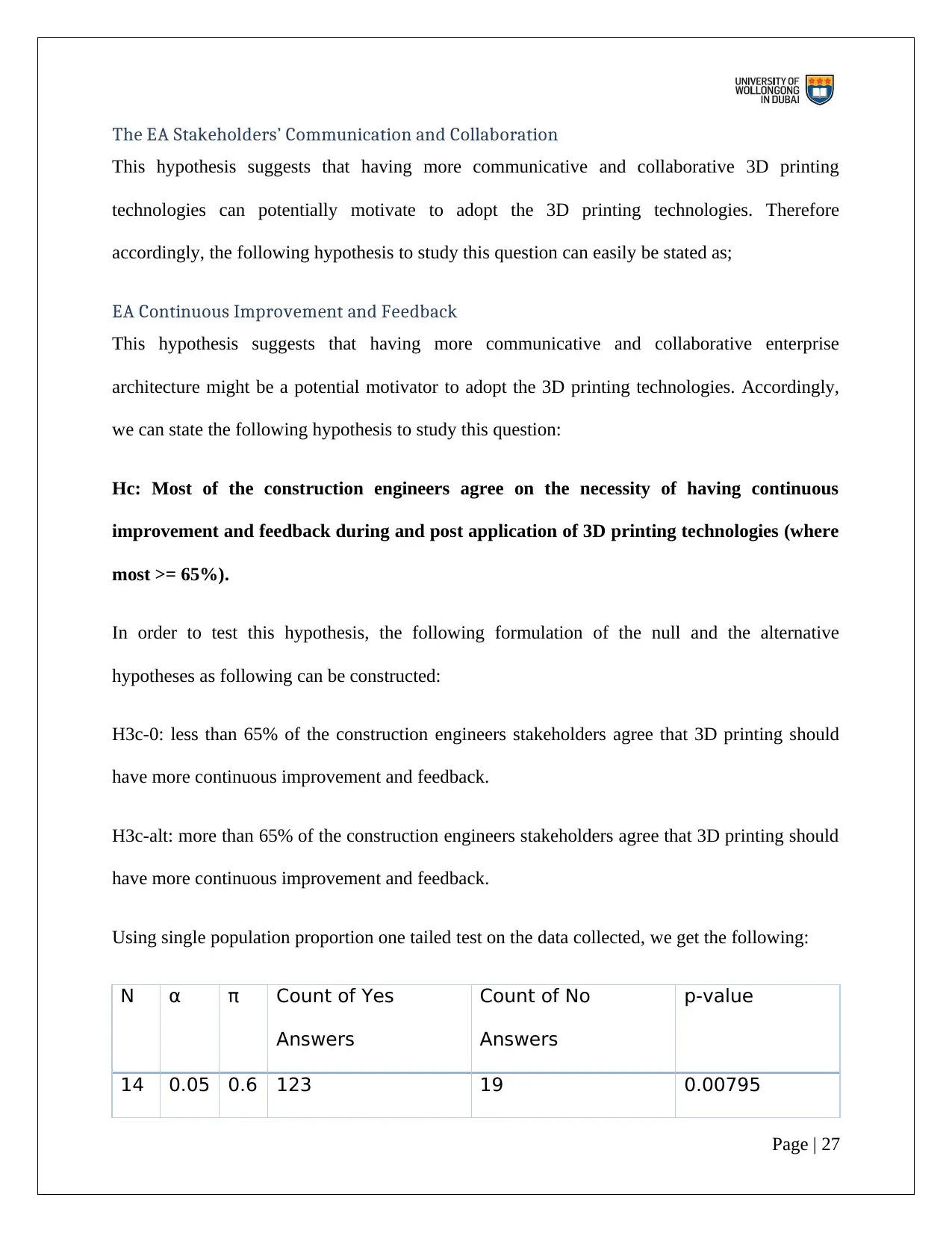
This hypothesis suggests that having more communicative and collaborative 3D printing
technologies can potentially motivate to adopt the 3D printing technologies. Therefore
accordingly, the following hypothesis to study this question can easily be stated as;
EA Continuous Improvement and Feedback
This hypothesis suggests that having more communicative and collaborative enterprise
architecture might be a potential motivator to adopt the 3D printing technologies. Accordingly,
we can state the following hypothesis to study this question:
Hc: Most of the construction engineers agree on the necessity of having continuous
improvement and feedback during and post application of 3D printing technologies (where
most >= 65%).
In order to test this hypothesis, the following formulation of the null and the alternative
hypotheses as following can be constructed:
H3c-0: less than 65% of the construction engineers stakeholders agree that 3D printing should
have more continuous improvement and feedback.
H3c-alt: more than 65% of the construction engineers stakeholders agree that 3D printing should
have more continuous improvement and feedback.
Using single population proportion one tailed test on the data collected, we get the following:
N α π Count of Yes
Answers
Count of No
Answers
p-value
14 0.05 0.6 123 19 0.00795
Page | 27
⊘ This is a preview!⊘
Do you want full access?
Subscribe today to unlock all pages.

Trusted by 1+ million students worldwide
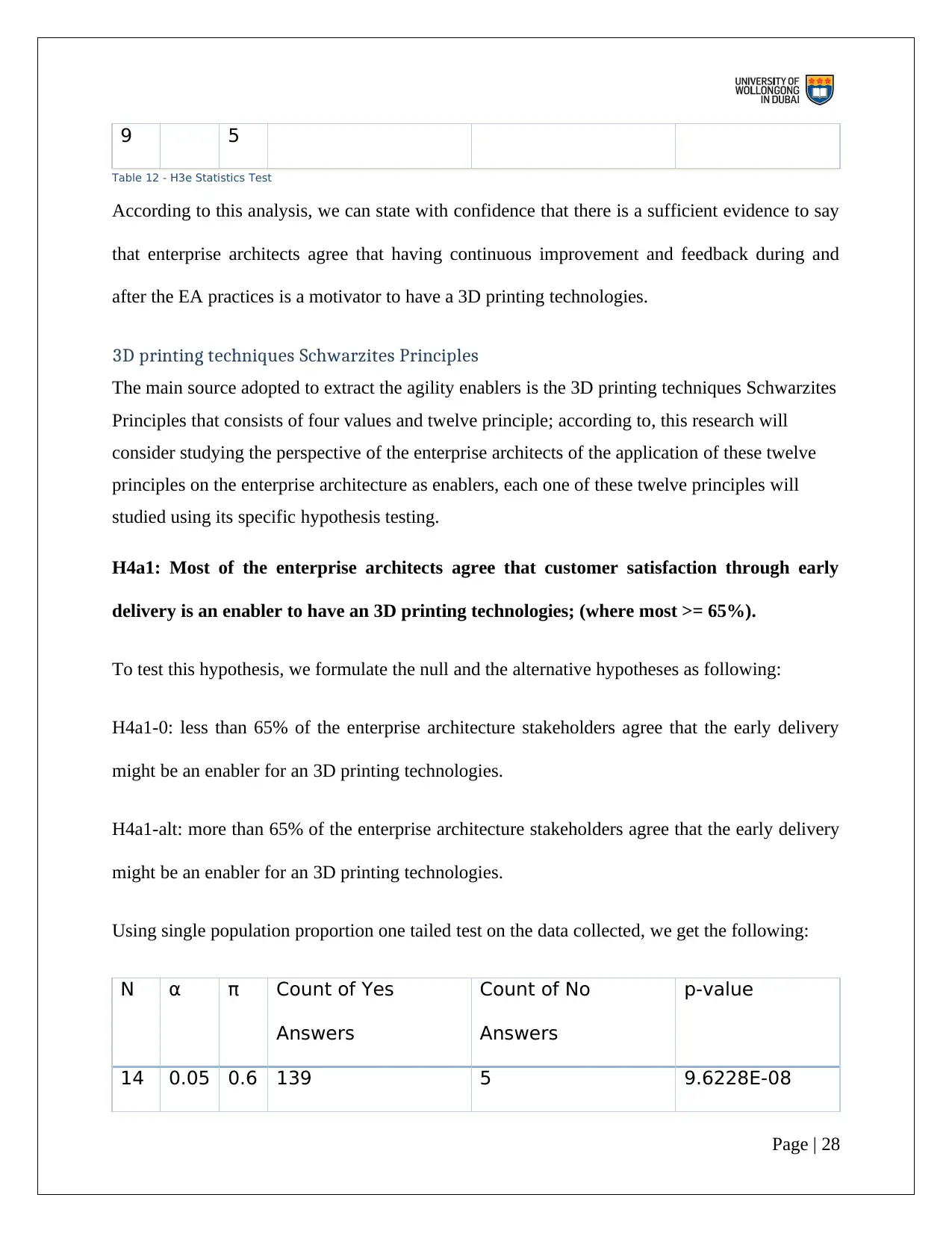
Table 12 - H3e Statistics Test
According to this analysis, we can state with confidence that there is a sufficient evidence to say
that enterprise architects agree that having continuous improvement and feedback during and
after the EA practices is a motivator to have a 3D printing technologies.
3D printing techniques Schwarzites Principles
The main source adopted to extract the agility enablers is the 3D printing techniques Schwarzites
Principles that consists of four values and twelve principle; according to, this research will
consider studying the perspective of the enterprise architects of the application of these twelve
principles on the enterprise architecture as enablers, each one of these twelve principles will
studied using its specific hypothesis testing.
H4a1: Most of the enterprise architects agree that customer satisfaction through early
delivery is an enabler to have an 3D printing technologies; (where most >= 65%).
To test this hypothesis, we formulate the null and the alternative hypotheses as following:
H4a1-0: less than 65% of the enterprise architecture stakeholders agree that the early delivery
might be an enabler for an 3D printing technologies.
H4a1-alt: more than 65% of the enterprise architecture stakeholders agree that the early delivery
might be an enabler for an 3D printing technologies.
Using single population proportion one tailed test on the data collected, we get the following:
N α π Count of Yes
Answers
Count of No
Answers
p-value
14 0.05 0.6 139 5 9.6228E-08
Page | 28
Paraphrase This Document
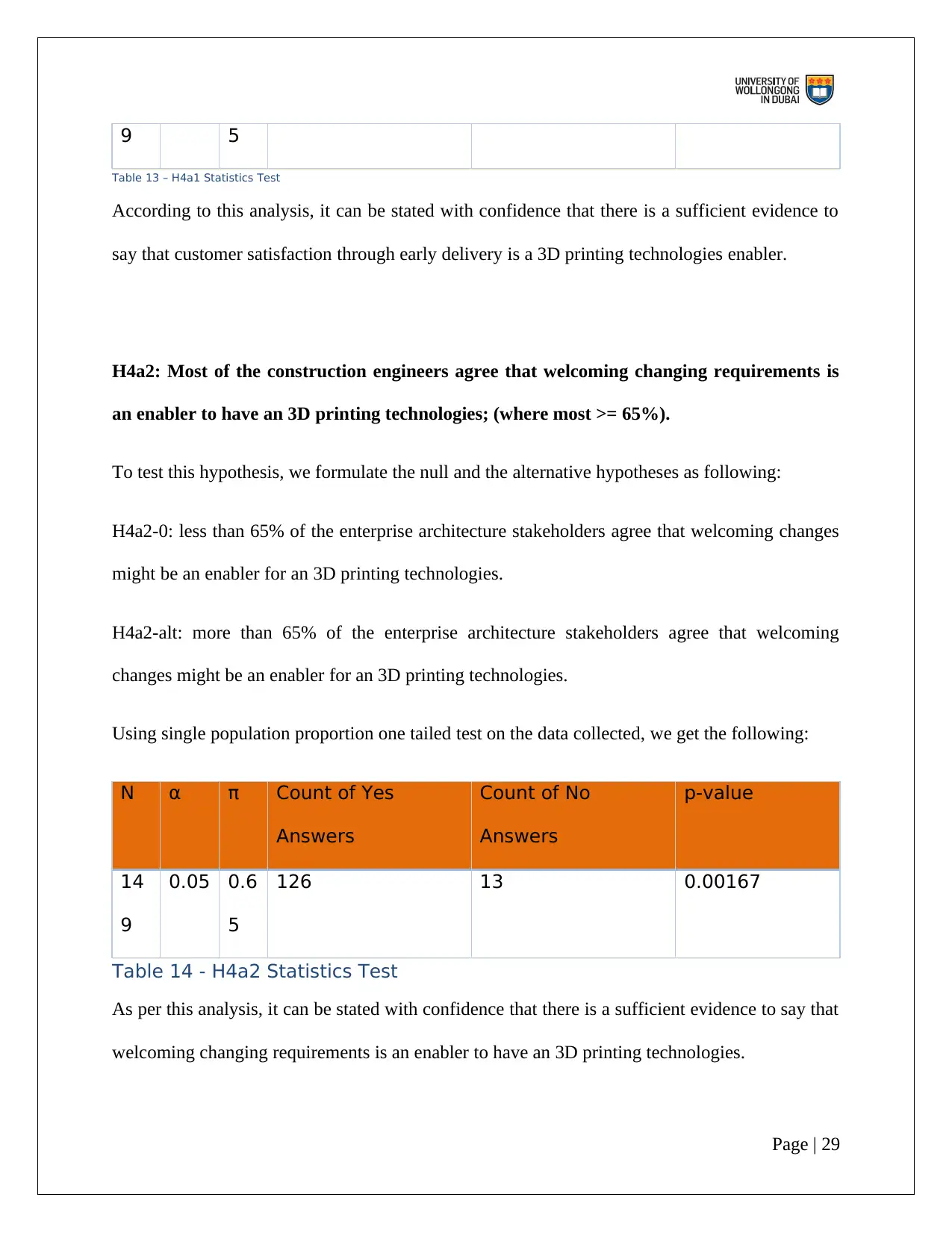
Table 13 – H4a1 Statistics Test
According to this analysis, it can be stated with confidence that there is a sufficient evidence to
say that customer satisfaction through early delivery is a 3D printing technologies enabler.
H4a2: Most of the construction engineers agree that welcoming changing requirements is
an enabler to have an 3D printing technologies; (where most >= 65%).
To test this hypothesis, we formulate the null and the alternative hypotheses as following:
H4a2-0: less than 65% of the enterprise architecture stakeholders agree that welcoming changes
might be an enabler for an 3D printing technologies.
H4a2-alt: more than 65% of the enterprise architecture stakeholders agree that welcoming
changes might be an enabler for an 3D printing technologies.
Using single population proportion one tailed test on the data collected, we get the following:
N α π Count of Yes
Answers
Count of No
Answers
p-value
14
9
0.05 0.6
5
126 13 0.00167
Table 14 - H4a2 Statistics Test
As per this analysis, it can be stated with confidence that there is a sufficient evidence to say that
welcoming changing requirements is an enabler to have an 3D printing technologies.
Page | 29

a 3D printing technologies; (where most >= 65%).
To test this hypothesis, we formulate the null and the alternative hypotheses as following:
H4a3-0: less than 65% of the construction engineers stakeholders agree that frequent delivery
might be an enabler for an 3D printing technologies.
H4a3-alt: more than 65% of the enterprise architecture stakeholders agree that frequent delivery
might be an enabler for a 3D printing technologies.
Using single population proportion one tailed test on the data collected, we get the following:
N α π Count of Yes
Answers
Count of No
Answers
p-value
14
9
0.05 0.6
5
126 22 0.00167
Table 15 - H4a3 Statistics Test
According to this analysis, we can state with confidence that there is a sufficient evidence to say
that frequent delivery is an enabler to have a 3D printing technologies.
H4a4: Most of the construction engineers agree that collaboration between stakeholders is
an enabler to have a 3D printing technologies; (where most >= 65%).
To test this hypothesis, we formulate the null and the alternative hypotheses as following:
Page | 30
⊘ This is a preview!⊘
Do you want full access?
Subscribe today to unlock all pages.

Trusted by 1+ million students worldwide
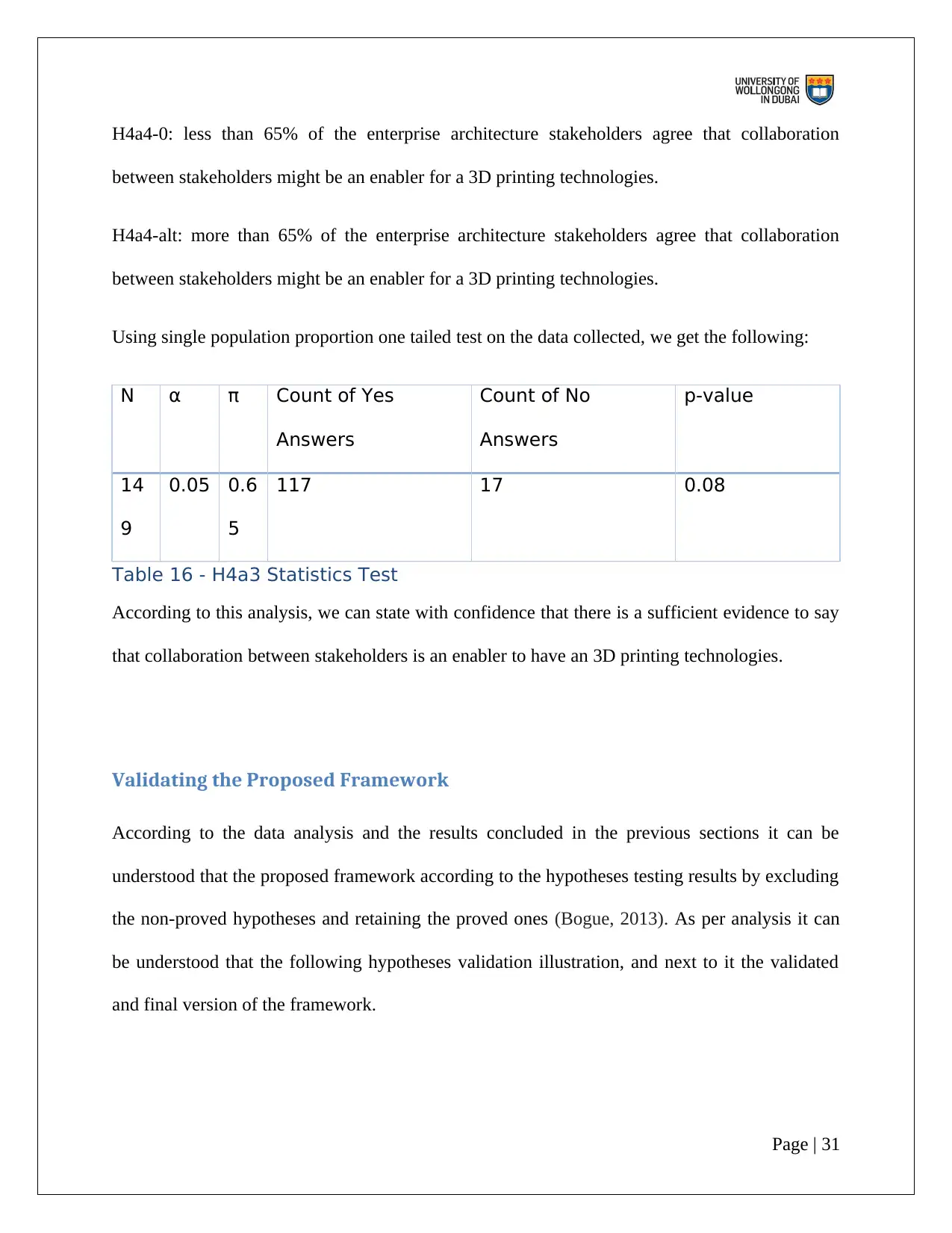
between stakeholders might be an enabler for a 3D printing technologies.
H4a4-alt: more than 65% of the enterprise architecture stakeholders agree that collaboration
between stakeholders might be an enabler for a 3D printing technologies.
Using single population proportion one tailed test on the data collected, we get the following:
N α π Count of Yes
Answers
Count of No
Answers
p-value
14
9
0.05 0.6
5
117 17 0.08
Table 16 - H4a3 Statistics Test
According to this analysis, we can state with confidence that there is a sufficient evidence to say
that collaboration between stakeholders is an enabler to have an 3D printing technologies.
Validating the Proposed Framework
According to the data analysis and the results concluded in the previous sections it can be
understood that the proposed framework according to the hypotheses testing results by excluding
the non-proved hypotheses and retaining the proved ones (Bogue, 2013). As per analysis it can
be understood that the following hypotheses validation illustration, and next to it the validated
and final version of the framework.
Page | 31
Paraphrase This Document
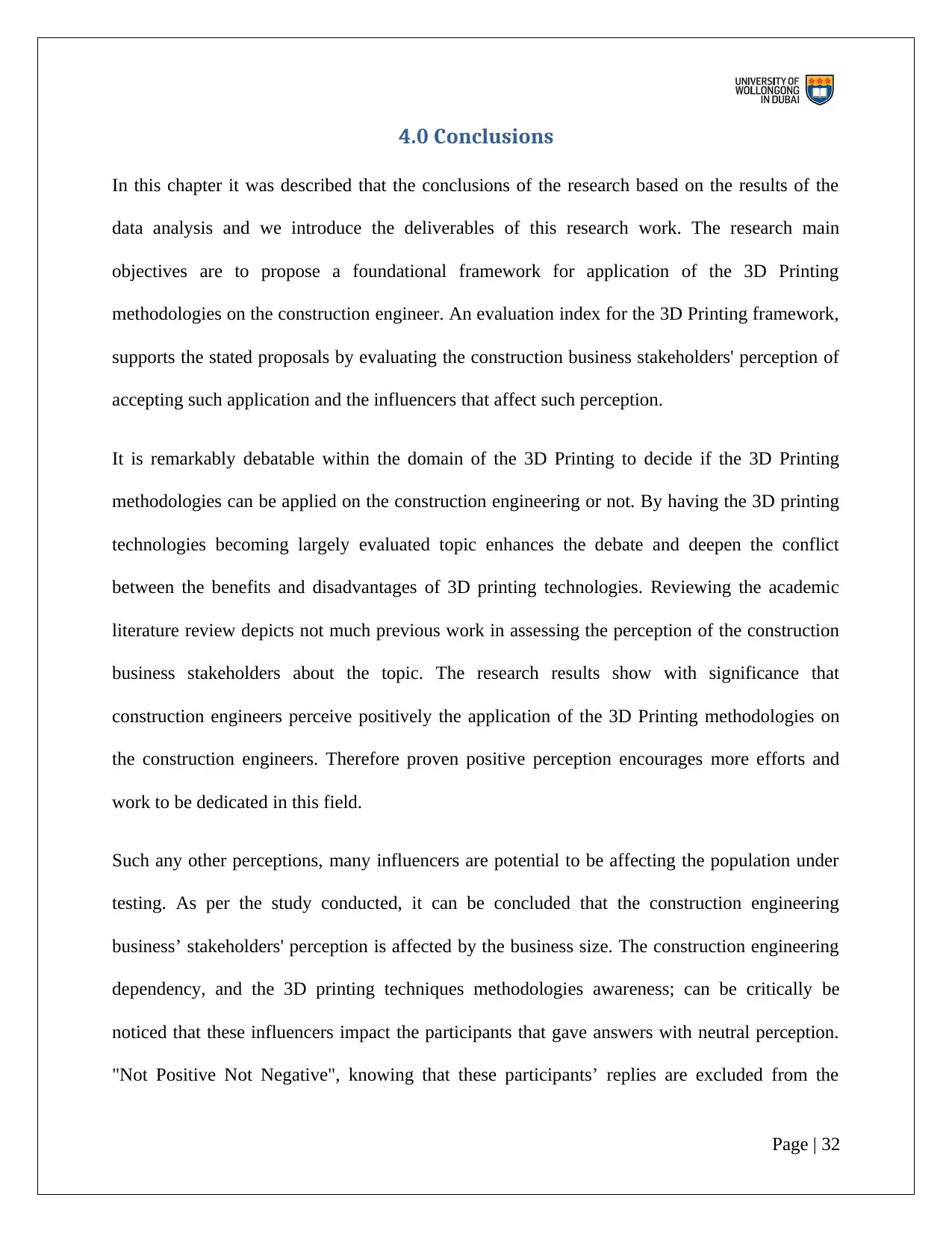
In this chapter it was described that the conclusions of the research based on the results of the
data analysis and we introduce the deliverables of this research work. The research main
objectives are to propose a foundational framework for application of the 3D Printing
methodologies on the construction engineer. An evaluation index for the 3D Printing framework,
supports the stated proposals by evaluating the construction business stakeholders' perception of
accepting such application and the influencers that affect such perception.
It is remarkably debatable within the domain of the 3D Printing to decide if the 3D Printing
methodologies can be applied on the construction engineering or not. By having the 3D printing
technologies becoming largely evaluated topic enhances the debate and deepen the conflict
between the benefits and disadvantages of 3D printing technologies. Reviewing the academic
literature review depicts not much previous work in assessing the perception of the construction
business stakeholders about the topic. The research results show with significance that
construction engineers perceive positively the application of the 3D Printing methodologies on
the construction engineers. Therefore proven positive perception encourages more efforts and
work to be dedicated in this field.
Such any other perceptions, many influencers are potential to be affecting the population under
testing. As per the study conducted, it can be concluded that the construction engineering
business’ stakeholders' perception is affected by the business size. The construction engineering
dependency, and the 3D printing techniques methodologies awareness; can be critically be
noticed that these influencers impact the participants that gave answers with neutral perception.
"Not Positive Not Negative", knowing that these participants’ replies are excluded from the
Page | 32
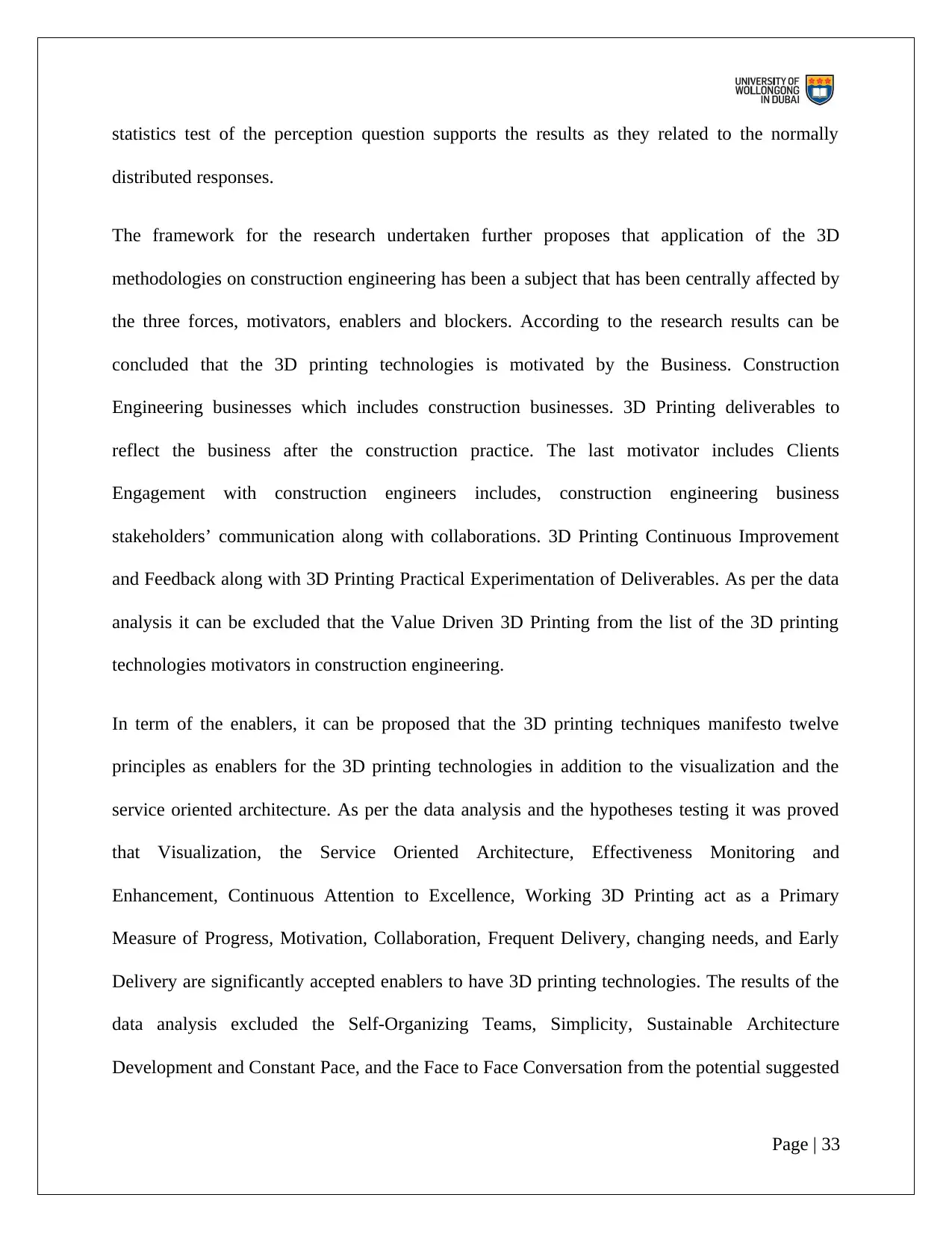
distributed responses.
The framework for the research undertaken further proposes that application of the 3D
methodologies on construction engineering has been a subject that has been centrally affected by
the three forces, motivators, enablers and blockers. According to the research results can be
concluded that the 3D printing technologies is motivated by the Business. Construction
Engineering businesses which includes construction businesses. 3D Printing deliverables to
reflect the business after the construction practice. The last motivator includes Clients
Engagement with construction engineers includes, construction engineering business
stakeholders’ communication along with collaborations. 3D Printing Continuous Improvement
and Feedback along with 3D Printing Practical Experimentation of Deliverables. As per the data
analysis it can be excluded that the Value Driven 3D Printing from the list of the 3D printing
technologies motivators in construction engineering.
In term of the enablers, it can be proposed that the 3D printing techniques manifesto twelve
principles as enablers for the 3D printing technologies in addition to the visualization and the
service oriented architecture. As per the data analysis and the hypotheses testing it was proved
that Visualization, the Service Oriented Architecture, Effectiveness Monitoring and
Enhancement, Continuous Attention to Excellence, Working 3D Printing act as a Primary
Measure of Progress, Motivation, Collaboration, Frequent Delivery, changing needs, and Early
Delivery are significantly accepted enablers to have 3D printing technologies. The results of the
data analysis excluded the Self-Organizing Teams, Simplicity, Sustainable Architecture
Development and Constant Pace, and the Face to Face Conversation from the potential suggested
Page | 33
⊘ This is a preview!⊘
Do you want full access?
Subscribe today to unlock all pages.

Trusted by 1+ million students worldwide
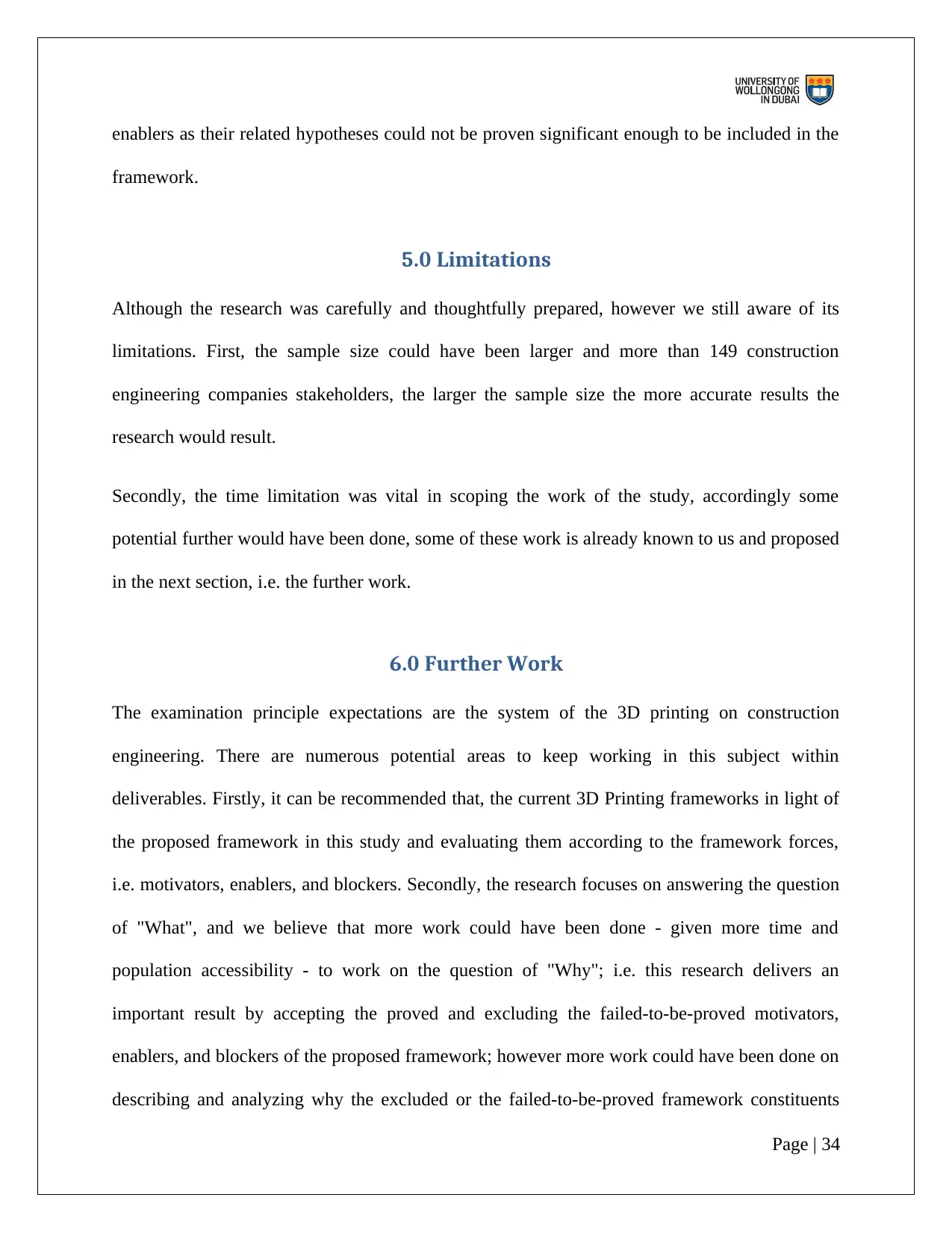
framework.
5.0 Limitations
Although the research was carefully and thoughtfully prepared, however we still aware of its
limitations. First, the sample size could have been larger and more than 149 construction
engineering companies stakeholders, the larger the sample size the more accurate results the
research would result.
Secondly, the time limitation was vital in scoping the work of the study, accordingly some
potential further would have been done, some of these work is already known to us and proposed
in the next section, i.e. the further work.
6.0 Further Work
The examination principle expectations are the system of the 3D printing on construction
engineering. There are numerous potential areas to keep working in this subject within
deliverables. Firstly, it can be recommended that, the current 3D Printing frameworks in light of
the proposed framework in this study and evaluating them according to the framework forces,
i.e. motivators, enablers, and blockers. Secondly, the research focuses on answering the question
of "What", and we believe that more work could have been done - given more time and
population accessibility - to work on the question of "Why"; i.e. this research delivers an
important result by accepting the proved and excluding the failed-to-be-proved motivators,
enablers, and blockers of the proposed framework; however more work could have been done on
describing and analyzing why the excluded or the failed-to-be-proved framework constituents
Page | 34
Paraphrase This Document
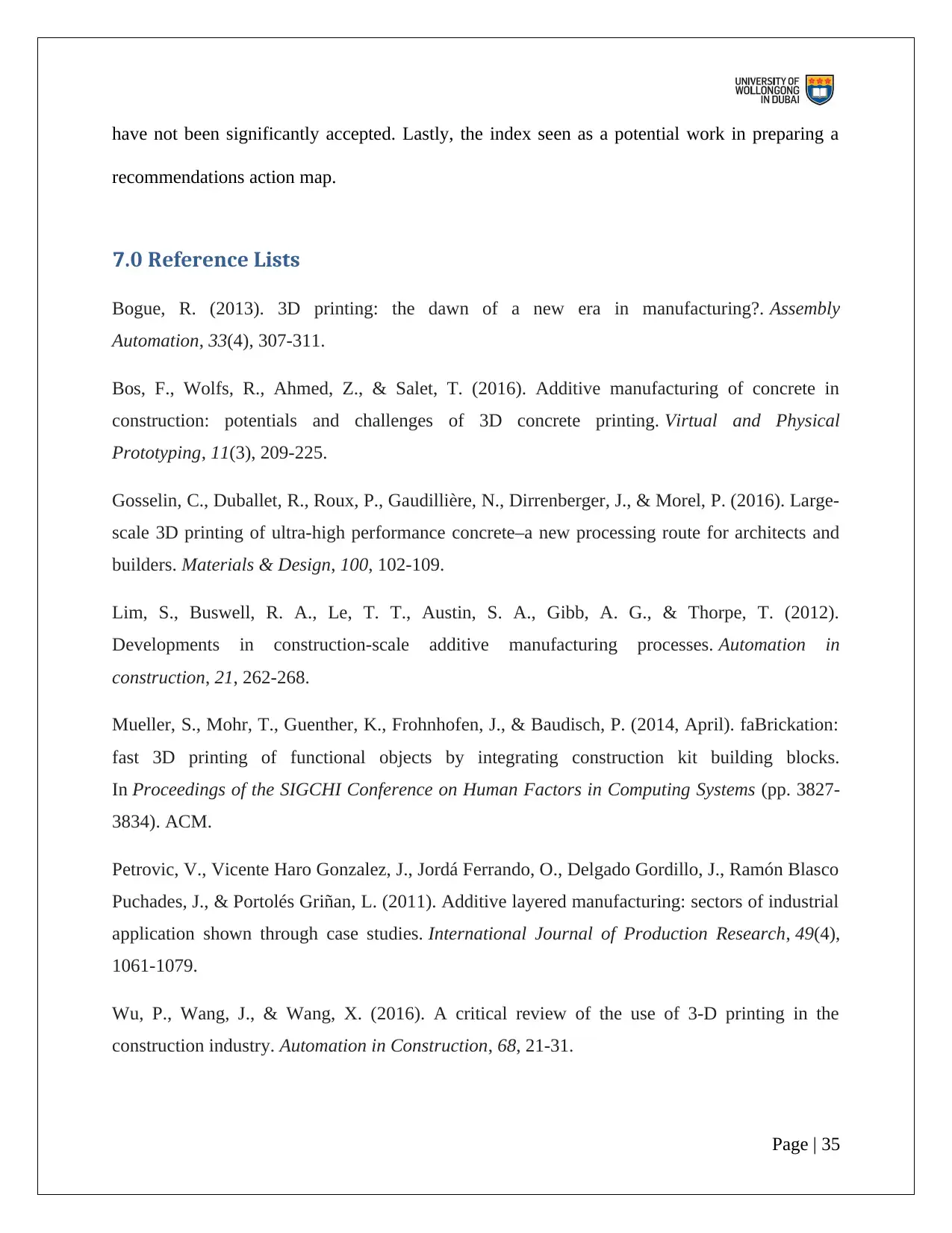
recommendations action map.
7.0 Reference Lists
Bogue, R. (2013). 3D printing: the dawn of a new era in manufacturing?. Assembly
Automation, 33(4), 307-311.
Bos, F., Wolfs, R., Ahmed, Z., & Salet, T. (2016). Additive manufacturing of concrete in
construction: potentials and challenges of 3D concrete printing. Virtual and Physical
Prototyping, 11(3), 209-225.
Gosselin, C., Duballet, R., Roux, P., Gaudillière, N., Dirrenberger, J., & Morel, P. (2016). Large-
scale 3D printing of ultra-high performance concrete–a new processing route for architects and
builders. Materials & Design, 100, 102-109.
Lim, S., Buswell, R. A., Le, T. T., Austin, S. A., Gibb, A. G., & Thorpe, T. (2012).
Developments in construction-scale additive manufacturing processes. Automation in
construction, 21, 262-268.
Mueller, S., Mohr, T., Guenther, K., Frohnhofen, J., & Baudisch, P. (2014, April). faBrickation:
fast 3D printing of functional objects by integrating construction kit building blocks.
In Proceedings of the SIGCHI Conference on Human Factors in Computing Systems (pp. 3827-
3834). ACM.
Petrovic, V., Vicente Haro Gonzalez, J., Jordá Ferrando, O., Delgado Gordillo, J., Ramón Blasco
Puchades, J., & Portolés Griñan, L. (2011). Additive layered manufacturing: sectors of industrial
application shown through case studies. International Journal of Production Research, 49(4),
1061-1079.
Wu, P., Wang, J., & Wang, X. (2016). A critical review of the use of 3-D printing in the
construction industry. Automation in Construction, 68, 21-31.
Page | 35
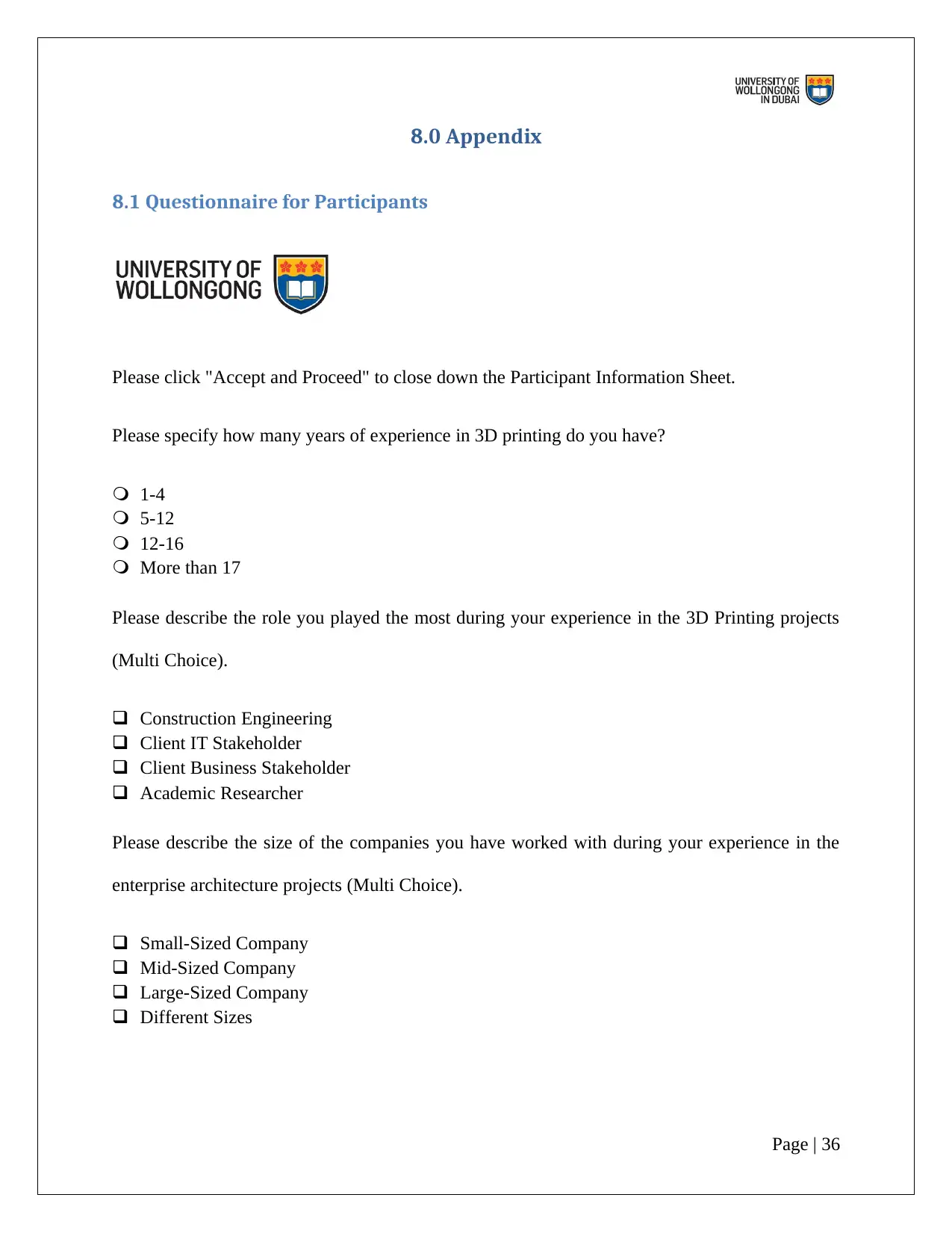
8.1 Questionnaire for Participants
Please click "Accept and Proceed" to close down the Participant Information Sheet.
Please specify how many years of experience in 3D printing do you have?
1-4
5-12
12-16
More than 17
Please describe the role you played the most during your experience in the 3D Printing projects
(Multi Choice).
Construction Engineering
Client IT Stakeholder
Client Business Stakeholder
Academic Researcher
Please describe the size of the companies you have worked with during your experience in the
enterprise architecture projects (Multi Choice).
Small-Sized Company
Mid-Sized Company
Large-Sized Company
Different Sizes
Page | 36
⊘ This is a preview!⊘
Do you want full access?
Subscribe today to unlock all pages.

Trusted by 1+ million students worldwide
Related Documents
Your All-in-One AI-Powered Toolkit for Academic Success.
+13062052269
info@desklib.com
Available 24*7 on WhatsApp / Email
![[object Object]](/_next/static/media/star-bottom.7253800d.svg)
© 2024 | Zucol Services PVT LTD | All rights reserved.





